MS Book and Mineral Company
Geological Society of America Publications
Newer GSA Special Papers - Scroll down
For older GSA Catalogs - click on these links:
GSA Memoirs
GSA Field Guides and Reviews of Engineering Geology
Our regular stock of older GSA Publications
GSA DNAG (Decade of North American Geology) Publications
Home Page
Contact information
Fossil Specimens
Mineral Specimens
Place an Order
Sale
Mining History Illustrations
When you purchase items (books, maps, fossils, minerals, folios) on this website, these discounts are now in effect:
If your order totals $50, take 10% off the total + shipping
If your order totals $100, take 15% off the total + shipping
If your order totals $200, take 20% off the total + shipping
If your order totals $300, take 25% off the total, + shipping
photo coming!
photo coming!
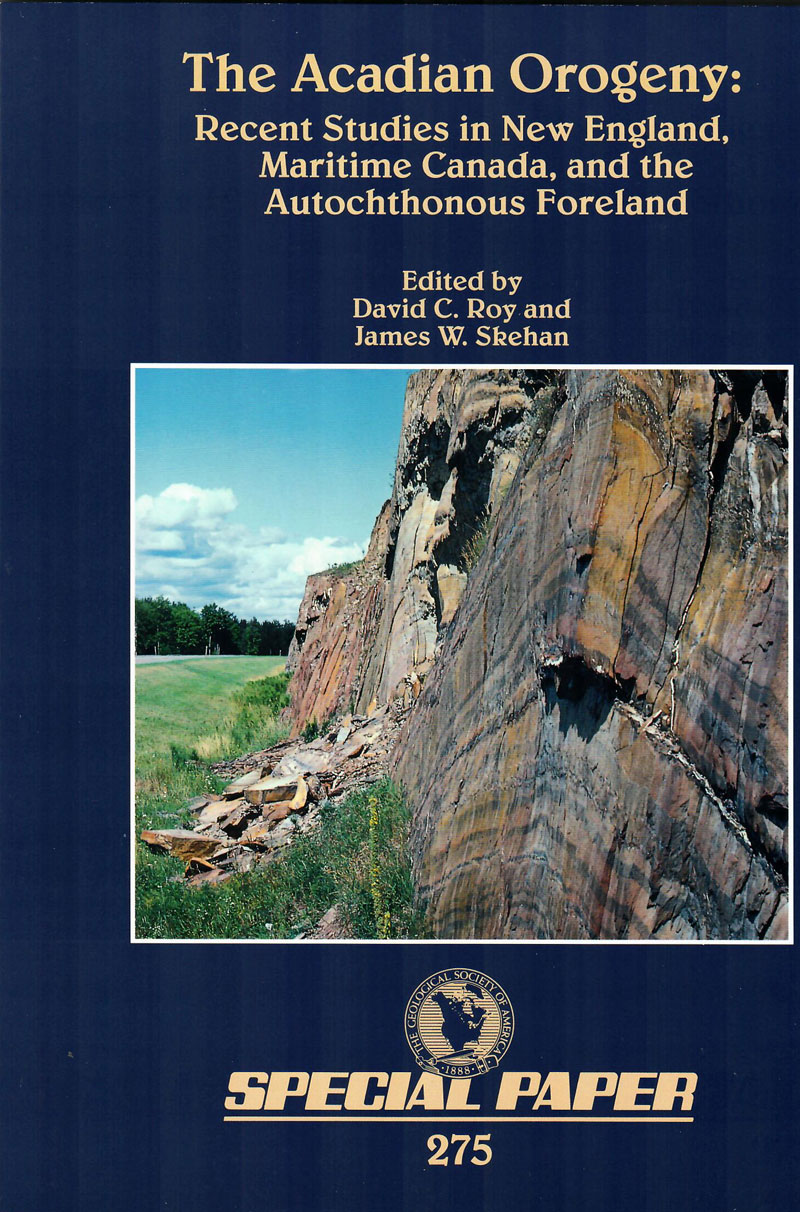
SP 275 - The Acadian Orogeny: Recent Studies in New England, Maritime Canada, and the Autochthonous Foreland
Description:
Roy, D. C. and Skehan, J. W., Ed. / THE ACADIAN OROGENY: Recent Studies in New England, Maritime Canada, and the Autochthonous Foreland, GSA SP 275, Boulder, 1993, pb, 171 pages, - 2 -, $ 10
An anthology of papers summarizing recent structural, statigraphic, and paleomagnetic studies of large subregions of the northern Appalachians in New England and northeastern Canada where the Acadian Orogeny was first recognized and is most pervasive. In addition to presenting new geologic and geomagnetic data, the mid-Paleozoic plate tectonic implications of the orogeny are explored. Regions covered include the eastern townships and Gaspé Peninsula of Quebec, central New Hampshire, eastern Maine, Newfoundland, and the Acadian foreland of the autochthonous Appalachian basin. Overview papers cover the broad context of the Acadian orogenesis in North America and Europe, the Paleozoic biostratigraphy of the Acadian orogen, and the paleomagnetic constraints on the accretion of tectonic terranes.
Contents:
Mid-Paleozoic Orogenesis in the North Atlantic. The Acadian Orogeny
Paleogeography, Accretionary History, and Tectonic Scenario: A Working Hypothesis for the Ordovician and Silurian Evolution of the Northern Appalachians
Comments on Cambrian-to-Carboniferous Biogeography and Its Implications for the Acadian Orogeny
The Sequence of Acadian Deformations in Central New Hampshire
Nature of the Acadian Orogeny in Eastern Maine
Acadian Deformations in the Southwestern Quebec Appalachians
Timing of the Deformation Events from Late Ordovician to Mid-Devonian in the Gaspé Peninsula
Acadian Orogeny in Newfoundland
Acadian Orogeny in West Newfoundland Definition, Character, and Significance
Stratigraphic Effects of the Acadian Orogeny in the Autochthonous Appalachian Basin
Index

SP 281 - Geological and geophysical evidence for deep subduction of continental crust beneath Pamir
Description:
Burtman, V. S. and Molnar, P. / GEOLOGICAL AND GEOPHYSICAL EVIDENCE FOR DEEP SUBDUCTION OF CONTINENTAL CRUST BENEATH PAMIR, GSA SP 281, Boulder, 1993, pb, 76 pages, - 1 -, $ 5
Summarizes and synthesizes published geological, geophysical, and geodetic observations, largely by Russian and Tadjik scientists, and merges them with an analysis of earthquakes to suggest subduction of intact continental lithosphere to a depth of 200 km beneath the Pamir in Central Asia. Some evidence suggests lithospheric subduction and studies imply it occurs along the northern margin of the Pamir at a rate of as much as 20 mm/a. Mapping and paleomagnetic observations indicate hundreds of kilometers of bending of tectonic belts across the Pamir consistent both with 300 km of underthrusting beneath the Pamir and with a comparable shortening within the range. Geophysical studies of deep structure corroborate the inference that only part of the convergence across the Pamir can be absorbed by shortening within the range, but that the subducted continental crust was thinner than normal.
Contents:
Geological Constraints on the Magnitude of Convergence Between the Pamir and the Rest of Eurasia
Deflections of Paleozoic and Mesozoic Sutures in the Pamir
Late Paleozoic Suturing of Continental Fragments to Asia
Indus-Tsang-po Suture Zone
Summary of Deflections of Sutures Around the Pamir
Paleomagnetic Declinations and the Bending of the Pamir Arc
Cenozoic Crustal Shortening Within the Pamir
Southern Pamir and Rushan-Pshart Zone
Central Pamir
Convergence of the Outer Margin of the Pamir with the South Tien Shan
Displacements of Cretaceous and Paleogene Facies Belts from the Tadjik Sedimentary Basin
Cenozoic Crustal Shortening Within the Outer Zone of the Pamir
Bounds on the Present and Initial Crustal Thicknesses
Isostasy, Seismic Refraction, and Present Crustal Thicknesses
Subsidence of the Tadjik Depression Inferred from Stratigraphic Sections
Active and Quaternary Deformation
Shallow-Focus Seismicity and Fault Plane Solutions of Earthquakes
Geologic, Geomorphic, and Archaeologic Evidence for Recent Deformation
Active Faults Along the Western Margin of the Pamir
The Trans-Alai Belt of Active Faulting
Active Faulting Along the North Slope of the Western
Peter the First Range
Active Faults in the Tadjik Depression
Active Faults Within the High Pamir
Summary of Quaternary and Holocene Faulting
Geodetic Evidence of Rates of Deformation in the Garm Region
Runou Valley
Sari-Pul' Network
Regional Triangulation and Trilateration Network
Summary of Geodetic Results
Partitioning of India's Convergence with Eurasia Across the Pamir
Intermediate-Depth Seismicity, Upper Mantle Structure, and Evidence of Subducted Lithosphere
Summary and Synthesis
Appendix A: Discussion of Earthquakes in the Pamir Region
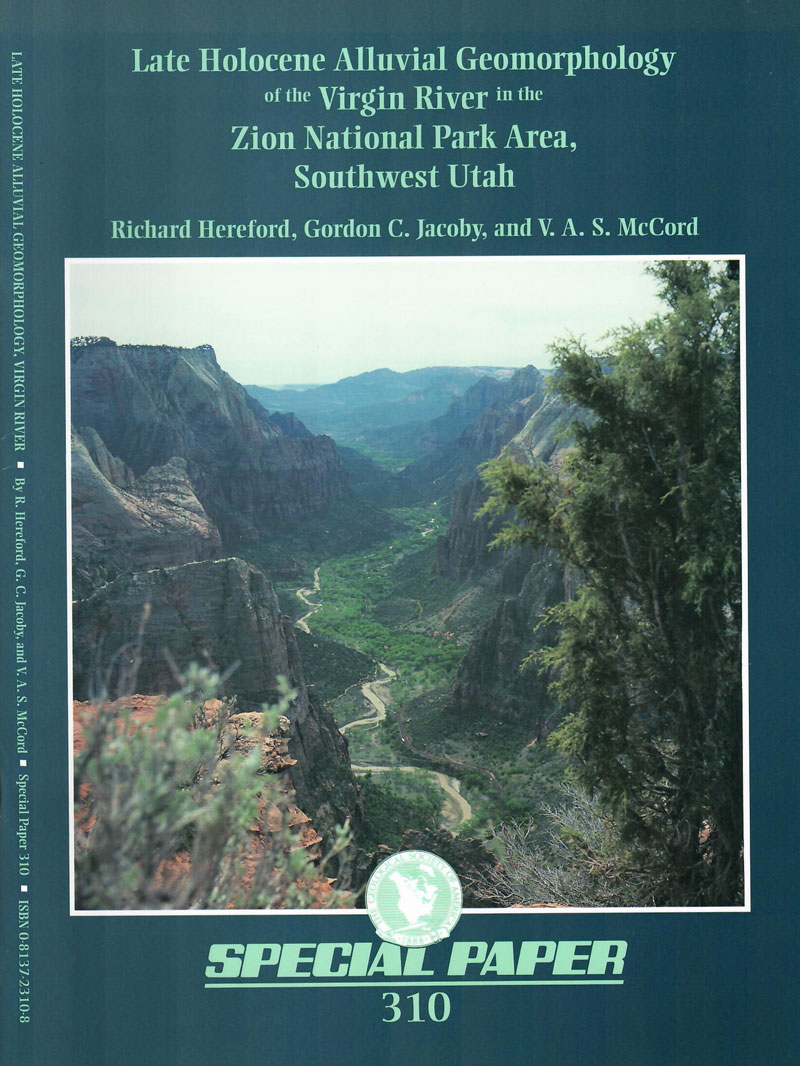
Description:
Hereford, R., et.al. / LATE HOLOCENE ALLUVIAL GEOMORPHOLOGY OF THE VIRGIN RIVER IN THE ZION NATIONAL PARK AREA, SOUTHWEST UTAH, GSA SP 310, Boulder, 1996, pb, 41 pages, - 1 -, $ 10
The Virgin River, in the spectacular canyons of Zion National Park near the southwest margin of the Colorado Plateau, is well suited for geomorphic research; it has a relatively wide alluvial valley and is free flowing, retaining the presettlement discharge regime. The research described in Special Paper 310 focused on how variations of water and sediment load modify valley morphology. A specific goal was understanding the timing and causes of arroyo cutting—the catastrophic, widespread degradation of stream channels in the southwest United States beginning in the late 1800s. Large-scale surficial geologic maps portray the terraces and alluvial deposits. Dated by archaeologic context and by tree-ring methods, these deposits correlate in time with dated late Holocene alluvium of other streams on the southern Colorado Plateau. Relocated historic photographs show the channel before, during, and after arroyo cutting. Dendrohydrologic reconstruction of streamflow demonstrates that arroyo cutting occurred during unusually wet climate with large floods and was preceded by an interval of very dry climate.
Contents:
Introduction
Geologic Setting of the Alluvial Valleys
Late Holocene Surficial Geology and Geomorphology
Floods and Historic Changes in the Channel of the Virgin River
Historic Photographs of the Virgin River
Streamflow History and Geomorphic Change of the Virgin River
Summary and Conclusions
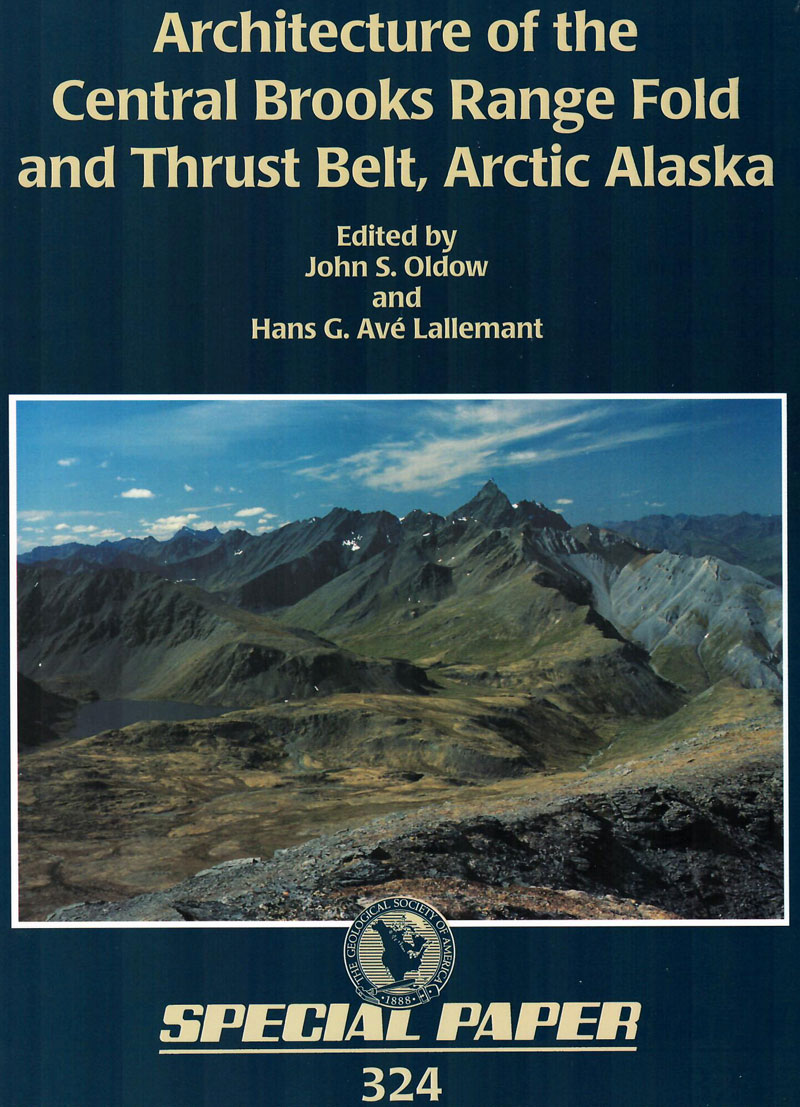
SP 324 - Architecture of the Central Brooks Range Fold and Thrust Belt, Arctic Alaska
Description:
Oldow, J. S. and Lallemant, H. G. A., Ed. / ARCHITECTURE OF THE CENTRAL BROOKS RANGE FOLD AND THRUST BELT, ARCTIC ALASKA, GSA SP 324, Boulder, 1998, pb, 317 pages, - 1 -, $ 10
The 17 papers in this volume present the results of a decade of geological and geophysical research centered largely along a north-south transect through the central Brooks Range of Arctic Alaska. Investigations and results center on a comprehensive description of the rocks and their tectonic evolution from the foreland to the hinterland of the orogen; the geometry and kinematics of contractional and extensional structures, regional and local stratigraphic relations, thermochronology, and the deep crustal structure of the Brooks Range and parts of the North Slope; and detailed descriptions of the major lithotectonic assemblages composing the orogenic belt. This volume offers a unique perspective of a fold-thrust belt and should prove useful in the study of other contractional belts around the world.
Contents:
Regional stratigraphy of the Brooks Range and North Slope, Arctic Alaska
Sedimentology and paleogeographic significance of Upper Devonian and Lower Mississippian clastic rocks, Endicott Mountains allochthon, central Brooks Range, Alaska
Spatial variation in structural style, Endicott Mountains allochthon, central Brooks Range, Alaska
Out-of-sequence thrusting and structural continuity of the Endicott Mountains allochthon around the eastern end of the Doonerak window, central Brooks Range, Alaska
Structure and lithology of the lower Paleozoic Apoon assemblage, eastern Doonerak window, central Brooks Range, Alaska
Structural development and kinematic history of ramp-footwall contraction in the Doonerak multiduplex, central Brooks Range, Arctic Alaska
Stratigraphy and paleogeographic setting of the eastern Skajit allochthon, central Brooks Range, Arctic Alaska
Envelopment thrusting and the structure of the eastern Skajit allochthon, central Brooks Range, Arctic Alaska
Petrology of eclogite and associated high-pressure metamorphic rocks, south-central Brooks Range, Alaska
Constraints on the cooling history of the central Brooks Range, Alaska, from fission-track and 40Ar/39Ar analyses
Tertiary uplift of the Mt. Doonerak antiform, central Brooks Range, Alaska: Apatite fission-track evidence from the Trans-Alaska crustal transect
Geology and Mesozoic structural history of the south-central Brooks Range, Alaska
Tectonothermal evolution of metamorphic rocks in the south-central Brooks Range, Alaska: Constraints from 40Ar/39Ar geochronology
Antithetic shear and the formation of back folds in the central Brooks Range fold and thrust belt, Alaska
Structural analysis of the Kobuk fault zone, north-central Alaska
Seismic profiling constraints on the evolution of the central Brooks Range, Arctic Alaska
Origin and tectonic evolution of the metamorphic sole beneath the Brooks Range ophiolite, Alaska
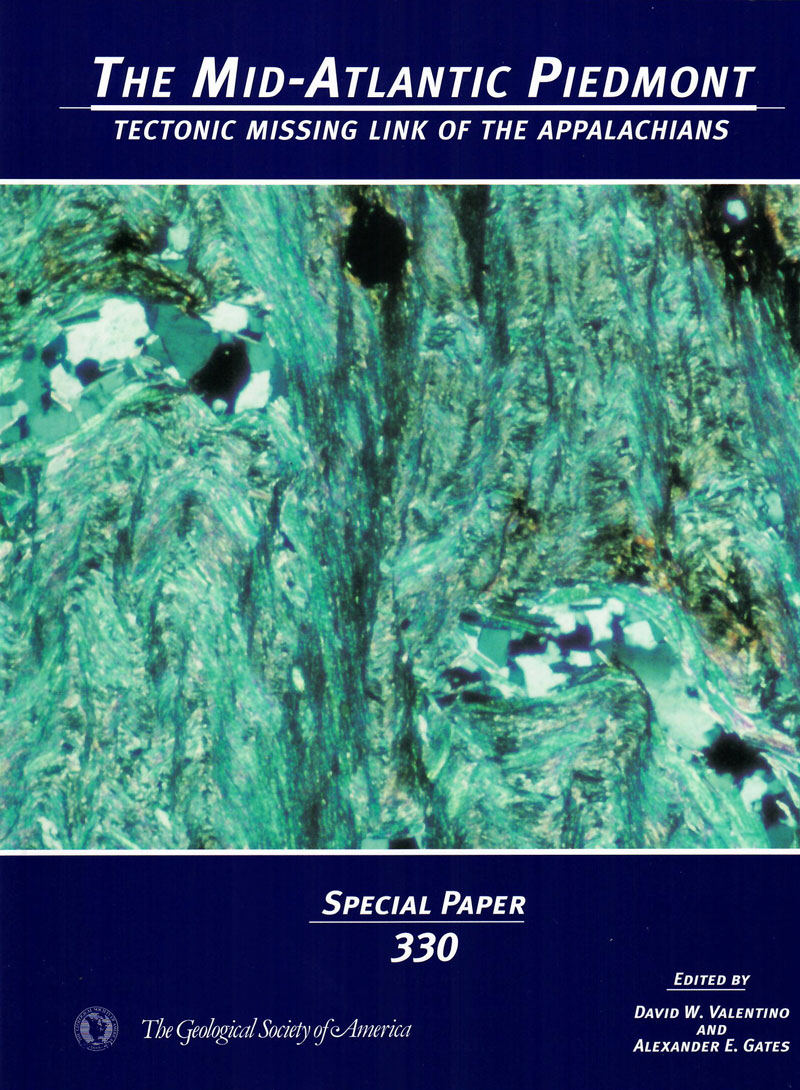
Description:
Valentino, D. W. and Gates, A. E., Ed. / THE MID-ATLANTIC PIEDMONT: THE MISSING LINK OF THE APPALACHIANS, GSA SP 330, Boulder, 1999, pb, 139 pages, - 1 -, $ 10
GSA and others have published many topical special volumes on northern and southern Appalachian tectonics. As critical advances in plate tectonics were applied to the rest of the Appalachians however, the Mid-Atlantic Piedmont was commonly neglected or included as an afterthought, making this part of the orogen a "missing link." Valentino and Gates have assembled a collection of papers that tie the central Appalachian Piedmont to the northern and southern regions by filling this void. Major themes include the impact of late Paleozoic dextral transpressive tectonism, the continuation of the Piedmont under the Atlantic coastal plain, and new results in the tectonothermal history of the Piedmont.
Contents:
1. Continuation of Appalachian Piedmont under New Jersey Coastal Plain
2. Interaction between Paleozoic strike-slip and thrust shear zones in the Philadelphia structural block, central Appalachian Piedmont
3. The distribution of overprinting metamorphic mineral assemblages in the Wissahickon Group, southeastern Pennsylvania
4. Late Paleozoic dextral transpression in the crystalline core of the Pennsylvania reentrant
5. Crystalline bedrock of the lowermost Susquehanna Valley: Implications for the tectonic assembly of the central Appalachian Piedmont
6. Late Paleozoic deformation within the Pleasant Grove shear zone, Maryland: Results from 40Ar/39Ar dating of white mica
7. Petrology of the Baltimore Gneiss in the northeast Towson Dome, Maryland Piedmont
8. Alleghanian transpressional orogenic float in the Baltimore terrane, central Appalachian Piedmont
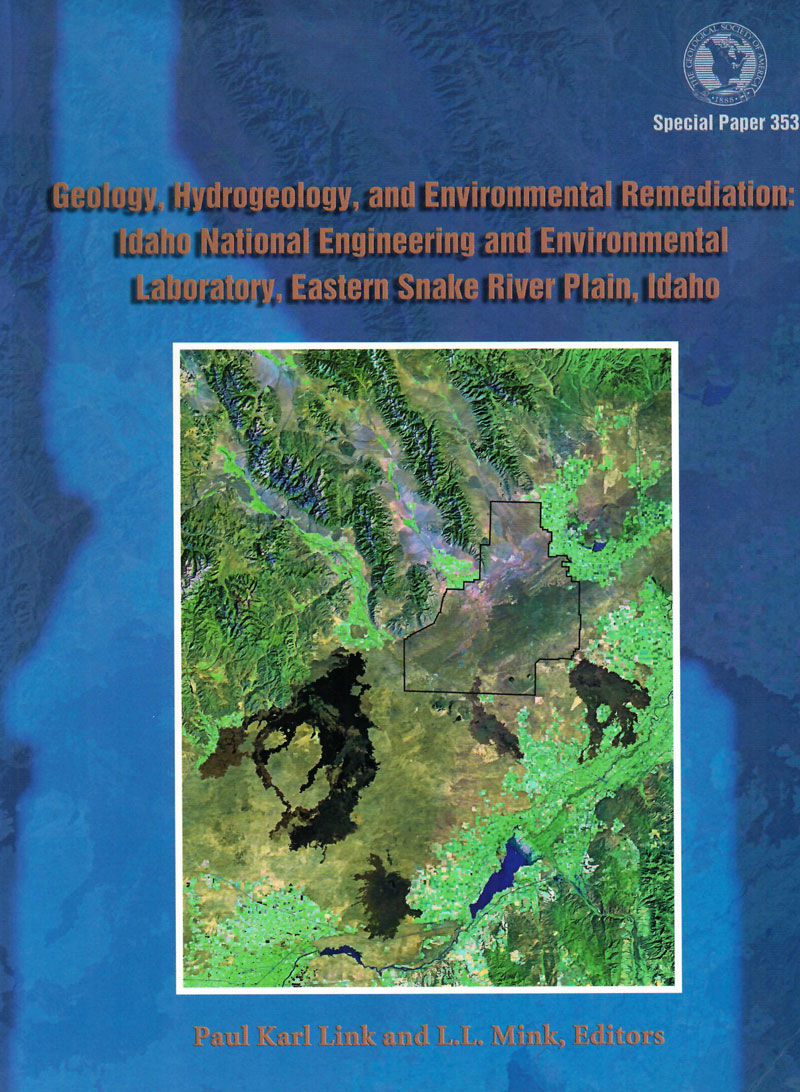
SP 353 - GEOLOGY, HYDROGEOLOGY, AND ENVIRONMENTAL REMEDIATION: IDAHO NATIONAL ENGINEERING AND ENVIRONMENTAL LABORATORY, EASTERN SNAKE RIVER PLAIN, IDAHO
Description:
Link, P. K. and Mink, L. L., Ed. / GEOLOGY, HYDROGEOLOGY, AND ENVIRONMENTAL REMEDIATION: IDAHO NATIONAL ENGINEERING AND ENVIRONMENTAL LABORATORY, EASTERN SNAKE RIVER PLAIN, IDAHO, GSA SP 353, Boulder, pb, 311 pages, - 1 -, $ 10
The Idaho National Environmental and Engineering Laboratory (INEEL), on the eastern Snake River Plain, occupies an arid geomorphic system that aggrades by closed-basin fluvial-lacustrine deposition and basaltic plains-volcanism. The area overlies the Snake River Aquifer, one of the largest and most dynamic bodies of subsurface fresh-water in North America, and lies in the wake of the Yellowstone Hot Spot, within the Basin and Range province. This is the first peer-reviewed comprehensive volume dealing with multidisciplinary geoscience research at a U.S. Department of Energy facility. The volume contains 19 papers that deal with environmental issues, bioremediation, hydrogeology, and regional geology. The interdisciplinary coverage of this research is a bridge between pure and applied geoscience in an environmentally critical area. The research was funded by the U.S. Department of Energy, and performed by the Idaho Universities Consortium, Idaho Water Resources Research Institute, and the Idaho and U.S. Geological Surveys.
Topics covered by papers in this volume include Quaternary and Pliocene climate history preserved in lake beds within a tectonically underfilled and volcanically silled basin, the Big Lost Trough; stochastic simulation of basalt flow heterogeneity, which allows greater precision of future Snake River Plain subsurface hydrologic models; state-of-the art studies dealing with TCE degradation, tracer tests, and intrinsic bioremediation in layered basalt flows; modelling of thermal water beneath the eastern Snake River Plain; extensive drillhole information and subsurface data about the INEEL area, which allows an unusually precise calculation of recurrence and geometry of basaltic eruptions; a discussion of present aspects of petrogenesis of Snake River Plain basalts; and a modified view of Holocene paleoflood hydrogeology of the Big Lost River.
Contents:
1. Introduction to the hydrogeology of the eastern Snake River Plain
2. Pliocene and Quaternary stratigraphic architecture and drainage systems of the Big Lost Trough, northeastern Snake River Plain, Idaho
3. Paleoenvironments of sedimentary interbeds in the Pliocene and Quaternary Big Lost Trough, eastern Snake River Plain, Idaho
4. Subsurface volcanology at Test Area North and controls on groundwater flow
5. Sedimentologic and hydrologic characterization of surficial sedimentary facies in the Big Lost Trough, Idaho National Engineering and Environmental Laboratory, eastern Idaho
6. Late Quaternary highstands in the Mud Lake and Big Lost Trough subbasins of Lake Terreton, Idaho
7. Holocene paleoflood hydrology of the Big Lost River, western Idaho National Engineering and Environmental Laboratory, Idaho
8. Tension cracks, eruptive fissures, dikes, and faults related to late Pleistocene-Holocene basaltic volcanism and implications for the distribution of hydraulic conductivity in the eastern Snake River Plain, Idaho
9. Morphology of inflated pahoehoe lavas and spatial architecture of their porous and permeable zones, eastern Snake River Plain, Idaho
10. Geochemical correlations and implications for the magmatic evolution of basalt flow groups at the Idaho National Engineering and Environmental Laboratory
11. Accumulation and subsidence of late Pleistocene basaltic lava flows of the eastern Snake River Plain, Idaho
12. Open-system evolution of a single episode of Snake River Plain magmatism
13. Chemical characteristics of thermal water beneath the eastern Snake River Plain
14. Genesis of alteration of Quaternary basalts within a portion of the eastern Snake River Plain aquifer
15. Stochastic simulation of aquifer heterogeneity in a layered basalt aquifer system, eastern Snake River Plain, Idaho
16. Modeling groundwater flow and contaminant transport in the Snake River Plain aquifer: A stochastic approach
17. Recirculating tracer test in fractured basalt
18. Characterization of microbial isolates from the Idaho National Engineering and Environmental Laboratory Test Area North aquifer: Identifying potential enzymatic pathways for toluene oxidation
19. Effect of basalt heterogeneity on intrinsic bioremediation processes in groundwater
SP 381 - Hydraulic tests of Miocene Volcanic Rocks at Yucca Mountain and Pahute Mesa and implications for ground water flow in the Southwest Nevada Volcanic Fireld, - 3 -, $ 10
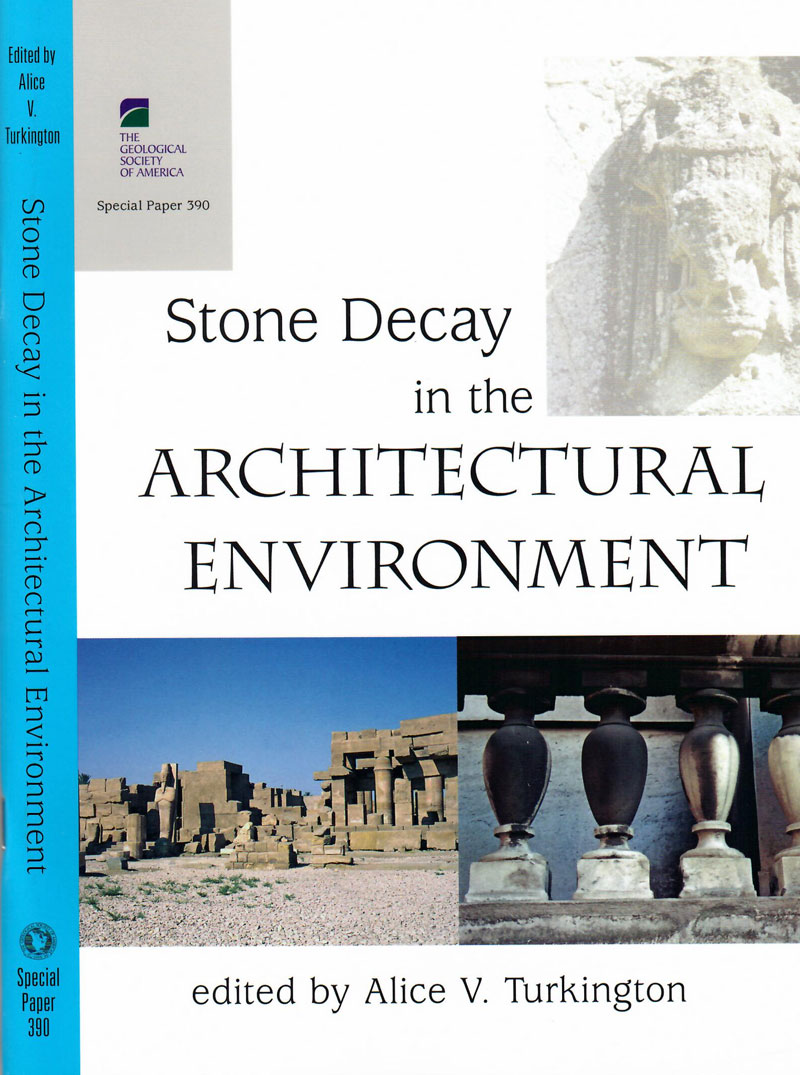
SP 390 - Stone Decay in the Architectural Environment
Description:
Turkington, A. V., Ed. / STONE DECAY IN THE ARCHITECTURAL ENVIRONMENT, GSA SP 390, Boulder, 2005, pb, 61 pages, - 1 -, $ 10
Some structures are constantly under threat from natural and human-induced decay processes, yet stone buildings, structures, and works of art remain a permanent feature in our cultural heritage. This volume presents recent research by an international group of geologists and geomorphologists on stone decay in the architectural environment, and it updates the latest theoretical and methodological advances in this field. The volume will be informative to earth scientists concerned with rock weathering in natural and urban locales, and it will be of benefit to those conservators, practitioners, scientists, and students whose interest lies at the interface between research and its application.
Contents:
1. Urban stone decay: The great weathering experiment?
2. Can stone decay be chaotic?
3. Weathering of serpentine stone buildings in the Philadelphia, Pennsylvania, region: A geographic approach related to acidic deposition
4. Surface-recession weathering of marble tombstones: New field data and constraints
5. Petra revisited: An examination of sandstone weathering research in Petra, Jordan
6. Characterization of swelling in clay-bearing stone

SP 421 - Advances in High-Pressure Mineralogy
Description:
Ohtani, E., Ed. / ADVANCES IN HIGH-PRESSURE MINERALOGY, GSA 421, Boulder, 2007, pb, 237 pages, - 1 -, $ 10
Composed of three parts, this book summarizes recent progress in high-pressure mineral physics. It is ideal for geoscience readers interested in new views of Earth’s processes and for those who want to introduce new experimental and theoretical techniques to their studies. Part 1 investigates the phase transformations of minerals in static and shocked conditions, which provide a basis for understanding Earth’s dynamic processes. Part 2 reveals the role of volatiles in the mantle. Volatiles are one of the most important agents for producing chemical differentiation of the mantle, and they play an important role in the generation of various magmas. As a result, people from areas such as petrology, volcanology, and tectonics will find this section particularly useful. Part 3 describes theoretical and experimental techniques in high-pressure mineral physics. Several techniques for in situ X-ray observations provide important applications for the analysis of geological samples.
Contents:
Part 1. Phase Transitions of Earth and Planetary Materials at High Pressure
1. Phase transitions of minerals in the transition zone and upper part of the lower mantle
2. Properties of lower mantle Al-(Mg,Fe)SiO3 perovskite
3. Discovery of post-perovskite phase transition and implications for the nature of the D" layer of the mantle
4. High-pressure phase transformations in the system FeO-MgO
5. High-pressure mineral assemblages in shocked meteorites and shocked terrestrial rocks: Mechanisms of phase transformations and constraints to pressure and temperature histories
Part 2. Role of Volatiles in the Earth
6. High-pressure mineralogy of diamond genesis
7. Melting of ice VII and new high-pressure, high-temperature amorphous ice
8. Effect of water on the phase relations in Earth’s mantle and deep water cycle
Part 3. New Techniques in Mineral Physics
9. Geophysical applications of nuclear resonant spectroscopy
10. Single-crystal structure and electron-density analyses of Earth’s interior under high-pressure and high-temperature conditions using synchrotron radiation
11. Phase-relation studies of mantle minerals by in situ X-ray diffraction using multianvil apparatus
12. Multianvil techniques in conjunction with synchrotron radiation at Deutsches ElektronenSYnchrotron (DESY) – HAmburger SYnchrotron LABor (HASYLAB)
13. X-ray microtomography under high pressure
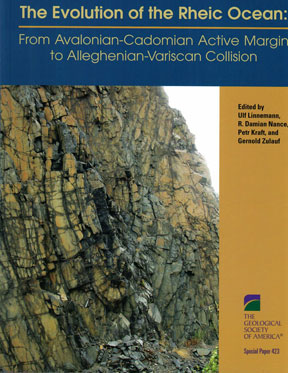
SP 423 - The Evolution of the Rheic Ocean: From Avalonian-Cadomian Active Margin to Alleghenian-Variscan Collision
Description:
Linnemann, U., et.al., Ed. / THE EVOLUTION OF THE RHEIC OCEAN: FROM AVALONIAN-CADOMIAN ACTIVE MARGIN TO ALLEGHENIAN-VARISCAN COLLISION, GSA SP 423, Boulder, 2007, pb, 630 pages, - 1 -, $ 10
This Special Paper includes 29 papers presented at several meetings of the International Geoscience Programme (IGCP) Project 497: “The Rheic Ocean: Its origin, evolution and correlatives.” The Rheic Ocean was one of the dominant oceans of the Paleozoic. Its origin can be traced to the Avalonian-Cadomian orogenies in the Latest Neoproterozoic. Closure of the Rheic Ocean began in the Lower Devonian and ended with the assembly of the supercontinent Pangaea. Its history involves North and South America, Africa, Baltica, and a number of peri-Gondwanan terranes. Papers mirror the history of the Rheic Ocean and document a chain of global events and produced orogenic belts that extend discontinuously from México to easternmost Europe. The ocean’s evolution was responsible for the formation of a wide variety of sedimentary basins; it significantly impacted the history of life, and it profoundly influenced contemporary paleoclimate and global environmental conditions. Fields of research involved in its study range widely and, as this book illustrates, include stratigraphy, sedimentology, paleontology, paleogeography, paleooceanography, igneous and metamorphic petrology, tectonics, structural geology, provenance analysis, geochemistry, geochronology, and paleomagnetism. Despite decades of research, aspects of the evolution of the Rheic Ocean remain controversial. With this book, the authors hope to answer a number of important questions and to encourage further research.
Contents:
1. The assembly of West Gondwana—The view from the Rio de la Plata craton
2. Geodynamic evolution of the northwestern Paleo-Gondwanan margin in the Moroccan Atlas at the Precambrian-Cambrian boundary
3. The continuum between Cadomian orogenesis and opening of the Rheic Ocean: Constraints from LA-ICP-MS U-Pb zircon dating and analysis of plate-tectonic setting (Saxo-Thuringian zone, northeastern Bohemian Massif, Germany)
4. The Lausitz graywackes, Saxo-Thuringia, Germany—Witness to the Cadomian orogeny
5. Paleontological data from the Early Cambrian of Germany and paleobiogeographical implications for the configuration of central Perigondwana
6. The Variscan orogeny in the Saxo-Thuringian zone—Heterogenous overprint of Cadomian/Paleozoic Peri-Gondwana crust
7. Far Eastern Avalonia: Its chronostratigraphic structure revealed by SHRIMP zircon ages from Upper Carboniferous to Lower Permian volcanic rocks (drill cores from Germany, Poland, and Denmark)
8. Nd-Sr-Pb isotopic signatures of Neoproterozoic–Early Paleozoic siliciclastic rocks in response to changing geotectonic regimes: A case study from the Barrandian area (Bohemian Massif, Czech Republic)
9. The diversity and geodynamic significance of Late Cambrian (ca. 500 Ma) felsic anorogenic magmatism in the northern part of the Bohemian Massif: A review based on Sm-Nd isotope and geochemical data
10. Sm-Nd isotope and trace element study of Late Proterozoic metabasalts (“spilites”) from the Central Barrandian domain (Bohemian Massif, Czech Republic)
11. Structural evolution of the Prague synform (Czech Republic) during Silurian times: An AMS, rock magnetism, and paleomagnetic study of the Svatý Jan pod Skalou dikes. Consequences for the nappes emplacement
12. Cadomian and Variscan metamorphic events in the Léon domain (Armorican Massif, France): PT data and EMP monazite dating
13. U-Pb depositional age for the upper Barrios Formation (Armorican Quartzite facies) in the Cantabrian zone of Iberia: Implications for stratigraphic correlation and paleogeography
14. Contrasting mantle sources and processes involved in a peri-Gondwanan terrane: A case study of pre-Variscan mafic intrusives from the autochthon of the Central Iberian Zone
15. Tectonic evolution of the upper allochthon of the Órdenes complex (northwestern Iberian Massif): Structural constraints to a polyorogenic peri-Gondwanan terrane
16. Crustal growth and deformational processes in the northern Gondwana margin: Constraints from the Évora Massif (Ossa-Morena zone, southwest Iberia, Portugal)
17. The Lower–Middle Cambrian boundary in the Mediterranean subprovince
18. Avalonian and Baltican terranes in the Moesian Platform (southern Europe, Romania, and Bulgaria) in the context of Caledonian terranes along the southwestern margin of the East European craton
19. Crete and the Minoan terranes: Age constraints from U-Pb dating of detrital zircons
20. Geological evolution of middle to late Paleozoic rocks in the Avalon terrane of northern mainland Nova Scotia, Canadian Appalachians: A record of tectonothermal activity along the northern margin of the Rheic Ocean in the Appalachian-Caledonide orogen
21. Vestige of the Rheic Ocean in North America: The Acatlán Complex of southern México
22. Provenance of the Granjeno Schist, Ciudad Victoria, México: Detrital zircon U-Pb age constraints and implications for the Paleozoic paleogeography of the Rheic Ocean
23. Ordovician calc-alkaline granitoids in the Acatlán Complex, southern México: Geochemical and geochronologic data and implications for the tectonics of the Gondwanan margin of the Rheic Ocean
24. Ordovician–Devonian oceanic basalts in the Cosoltepec Formation, Acatlán Complex, southern México: Vestiges of the Rheic Ocean?
25. P-T-t constraints on exhumation following subduction in the Rheic Ocean from eclogitic rocks in the Acatlán Complex of southern México
26. Life and death of a Cambrian–Ordovician basin: An Andean three-act play featuring Gondwana and the Arequipa-Antofalla terrane
27. A Late Ordovician ice sheet in South America: Evidence from the Cancañiri tillites, southern Bolivia
28. Sedimentary basins in the southwestern Siberian craton: Late Neoproterozoic–Early Cambrian rifting and collisional events
29. Aluminum phosphate in Proterozoic metaquartzites: Implications for the Precambrian oceanic P budget and development of life

SP 430 - Plates, Plumes, and Planetary Processes
Description:
Foulger, G. R. and Jurdy, D. M., Ed. / PLATES, PLUMES, AND PLANETARY PROCESSES, GSA SP 430, Boulder, 2007, pb, 974 pages, - 1 -, $ 30
This beautiful compendium of work documents the state-of-play of the current fundamental debate on whether or not mantle plumes exist and the origin of “hot spot” volcanism on the surface of Earth, Mars, and Venus. The book is fully interdisciplinary and encompasses all branches of earth science, including geophysics, geochemistry, heat, temperature, tectonics, petrology, mantle dynamics, impacts, and syntheses reconciling several branches of earth science. Included are chapters that advocate the plume model as well as ones that advocate alternative models. Most chapters are designed to be accessible to students and scientists in different subdisciplines within the earth sciences, making them doubly valuable to specialists and nonspecialists alike. The book is designed to enjoy a long lifetime of usefulness, functioning as both a landmark document for the subject today and a valuable reference work for students, scholars, and informed lay people for the future. It will be equally valuable for supporting advanced undergraduate or postgraduate courses and research scientists working at the forefront of “hot spot” science, and is an essential addition to the bookshelves of every science library, earth science teacher, and research scientist who aspires to push back the frontiers of this exciting subject. With over 180 color plates, it will be a beautiful addition to the library of anyone fascinated by volcanoes—one of nature’s most exciting and extraordinary phenomena.
Contents:
Plates and Plumes
1. The “plate” model for the genesis of melting anomalies
2. Origins of the plume hypothesis and some of its implications
3. The eclogite engine: Chemical geodynamics as a Galileo thermometer
4. Plate velocities in the hotspot reference frame
Mantle Convection and Seismology
5. Implications of lower-mantle structural heterogeneity for the existence and nature of whole-mantle plumes
6. The structure of thermal plumes and geophysical observations
7. Seismic observations of transition-zone discontinuities beneath hotspot locations
8. Lower-mantle material properties and convection models of multiscale plumes
9. Global plume-fed asthenosphere flow—I: Motivation and model development
10. Global plume-fed asthenosphere flow—II: Application to the geochemical segmentation of mid-ocean ridges
11. The Hawaiian Swell pilot experiment—Evidence for lithosphere rejuvenation from ocean bottom surface wave data
Heat and Temperature
12. Crystallization temperatures of tholeiite parental liquids: Implications for the existence of thermally driven mantle plumes
13. Potential effects of hydrothermal circulation and magmatism on heatflow at hotspot swells
14. Crustal geotherm in southern Deccan basalt province, India: The Moho is as cold as adjoining cratons
Geochronology, Hotspot Fixity, and Reference Frames
15. A quantitative tool for detecting alteration in undisturbed rocks and minerals—I:Water, chemical weathering, and atmospheric argon
16. A quantitative tool for detecting alteration in undisturbed rocks and minerals—II: Application to argon ages related to hotspots
17. Divergence between paleomagnetic and hotspot-model–predicted polar wander for the Pacific plate with implications for hotspot fixity
18. Global kinematics in deep versus shallow hotspot reference frames
19. Ridge-crossing seamount chains: A nonthermal approach
Oceanic Melting Anomalies
20. The OIB paradox
21. ΔNb and the role of magma mixing at the East Pacific Rise and Iceland
22. Speculations on Cretaceous tectonic history of the northwest Pacific and a tectonic origin for the Hawaii hotspot
23. A plate model for Jurassic to Recent intraplate volcanism in the Pacific Ocean basin
24. Propagation of the Hawaiian-Emperor volcano chain by Pacific plate cooling stress
25. Geophysical characterization of mantle melting anomalies: A crustal view
26. The North Atlantic Igneous Province: A review of models for its formation
27. Origin of the Bermuda volcanoes and the Bermuda Rise: History, observations, models, and puzzles
Continental Melting Anomalies
28. Lithospheric control of Gondwana breakup: Implications of a trans-Gondwana icosahedral fracture system
29. The origin of post-Paleozoic magmatism in eastern Paraguay
30. The origin of the Columbia River flood basalt province: Plume versus nonplume models
31. Evaluation of different models for the origin of the Siberian Traps
32. Eastern Anatolia: A hotspot in a collision zone without a mantle plume
33. Phantom plumes in Europe and the circum-Mediterranean region
34. Mechanisms of crustal growth in large igneous provinces: The north Atlantic province as a case study
35. K-T magmatism and basin tectonism in western Rajasthan, India, results from extensional tectonics and not from Réunion plume activity
36. Plume-related regional prevolcanic uplift in the Deccan Traps: Absence of evidence, evidence of absence
37. Nd and Sr isotope systematics and geochemistry of a plume-related Early Cretaceous alkaline-mafic-ultramafic igneous complex from Jasra, Shillong plateau, northeastern India
38. A bimodal large igneous province and the plume debate: The Paleoproterozoic Dongargarh Group, central India
39. Thick, high-velocity crust in the Emeishan large igneous province, southwestern China: Evidence for crustal growth by magmatic underplating or intraplating
Planetary Evolution
40. The coronae of Venus: Impact, plume, or other origin?
41. An alternative Venus
42. Interaction between local magma ocean evolution and mantle dynamics on Mars
Education
43. The mantle plume debate in undergraduate geoscience education: Overview, history, and recommendations
Platonics and Plumacy
44. Graphic solutions to problems of plumacy
45. Plumacy reprise
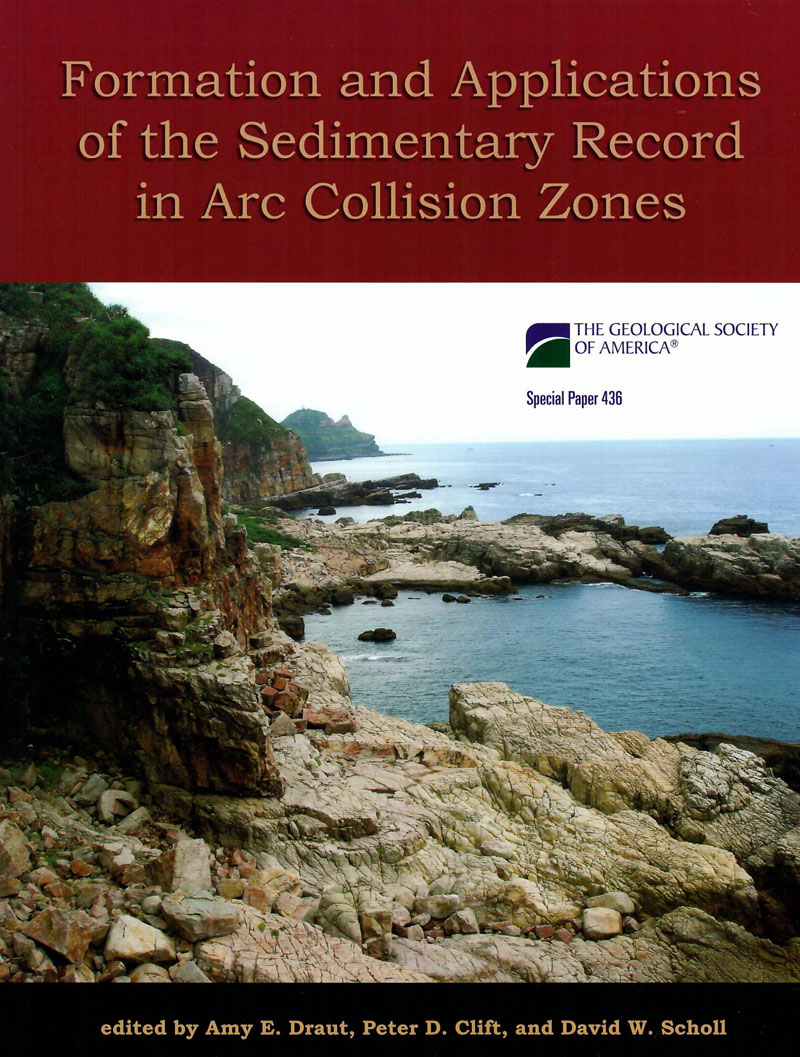
SP 436 - Formation and Applications of the Sedimentary Record in Arc Collision Zones
Description:
Draut, A. E., Clift, P. D., and Scholl, D. W. / FORMATION AND APPLICATIONS OF THE SEDIMENTARY RECORD IN ARC COLLISION ZONES, GSA 436, Boulder, 2008, pb, 435 pages, - 1 -, $ 10
Inspired by a GSA Penrose Conference held in 2005 (cosponsored by the International Association of Sedimentologists and the British Sedimentological Research Group), the 17 papers in this volume explore sedimentary environments in arc collision zones and their utility in recording the evolution of modern and ancient convergent margins. The first set of papers in the collection focuses on formation and evolution of the sedimentary record in arc settings and arc collision zones, concentrating on modern intra-oceanic examples. Papers include studies of flexural modeling and factors that affect development of siliciclastic and carbonate deposits around modern arcs. The second half of the volume presents new applications of arc sedimentary records. These relate primarily to constraining tectonic events in the evolution of arc systems, but also concern the links among tectonic uplift, collision, and geomorphic and climatic feedback mechanisms in arc collision zones.
Contents:
1. Preservation of forearc basins during island arc–continent collision: Some insights from the Ordovician of western Ireland
2. Basin formation by volcanic arc loading
3. Cenozoic arc processes in Indonesia: Identification of the key influences on the stratigraphic record in active volcanic arcs
4. Carbonate-platform facies in volcanic-arc settings: Characteristics and controls on deposition and stratigraphic development
5. Sediment waves in the Bismarck Volcanic Arc, Papua New Guinea
6. The Lichi Mélange: A collision mélange formation along early arcward backthrusts during forearc basin closure, Taiwan arc-continent collision
7. Oblique subduction in island arc collision setting: Unique sedimentation, accretion, and deformation processes in the Boso TTT-type triple junction area, NW Pacific
8. The West Crocker formation of northwest Borneo: A Paleogene accretionary prism
9. Temporal changes in the composition of Miocene sandstone related to collision between the Honshu and Izu arcs, central Japan
10. Cenozoic volcanic arc history of East Java, Indonesia: The stratigraphic record of eruptions on an active continental margin
11. New constraints on the sedimentation and uplift history of the Andaman-Nicobar accretionary prism, South Andaman Island
12. Post-collisional collapse in the wake of migrating arc-continent collision in the Ilan Basin, Taiwan
13. The Guerrero Composite Terrane of western Mexico: Collision and subsequent rifting in a supra-subduction zone
14. Tectonic architecture of an arc-arc collision zone, Newfoundland Appalachians
15. The Catalina Schist: Evidence for middle Cretaceous subduction erosion of southwestern North America
16. Sedimentary response to arc-continent collision, Permian, southern Mongolia
17. Links among mountain building, surface erosion, and growth of an accretionary prism in a subduction zone — An example from southwest Japan
18. Index

SP 439 - Late Cenozoic Drainage History of the Southwestern Great Basin and Lower Colorado River Region: Geologic and Biotic Perspectives
Description:
Reheis, M. C., Hershler, R. and Miller, D. M. / LATE CENOZOIC DRAINAGE HISTORY OF THE SOUTHWESTERN GREAT BASIN AND LOWER COLORADO RIVER REGION: GEOLOGIC AND BIOTIC PERSPECTIVES, GSA 439, Boulder, 2008. pb, 432 pages, - 1 -, $ 10
The late Cenozoic history of surface waters in the arid deserts of the southwestern Great Basin and lower Colorado River region has fascinated scientists for more than two centuries. A wide diversity of closed basins with ancient lake beds and partially integrated drainage systems tantalizes scientists with the potential for studies of fundamental geologic and biologic processes, including landscape evolution, climate history, and tectonics; the distribution of regional aquatic biota; and the history of isolation and speciation. Early models of regional drainage history have been revised during the past decade, along with biogeographic inquiries of diverse aquatic organisms. The papers in this volume summarize and integrate geologic and biotic perspectives to provide a current synthesis of the aquatic history of this fascinating western North American region, and to develop broader perspectives on the types of research addressing issues of regional drainage history.
Contents:
DEATH VALLEYAND TRIBUTARY DRAINAGE SYSTEMS
1. Reconstructing late Pliocene to middle Pleistocene Death Valley lakes and river systems as a test of pupfish (Cyprinodontidae) dispersal hypotheses
2. The western North American pupfish clade (Cyprinodontidae: Cyprinodon): Mitochondrial DNA divergence and drainage history
3. Multistage late Cenozoic evolution of the Amargosa River drainage, southwestern Nevada and eastern California
4. Ancient vicariance and recent dispersal of springsnails (Hydrobiidae: Pyrgulopsis) in the Death Valley system, California-Nevada
5. Genetic zoogeography of the Hyalella azteca species complex in the Great Basin: Rapid rates of molecular diversification in desert springs
Jonathan D.S. Witt, Doug L. Threloff, and Paul D.N. Hebert 103
6. Geological and hydrological history of the paleo–Owens River drainage since the late Miocene
7. Late Pleistocene lakes and wetlands, Panamint Valley, Inyo County, California
8. Late Quaternary, MIS 6–8 shoreline features of pluvial Owens Lake, Owens Valley, eastern California
9. Late Pleistocene shorelines of Owens Lake, California, and their hydroclimatic and tectonic implications
10. Lake Manix shorelines and Afton Canyon terraces: Implications for incision of Afton Canyon
11. Lake Thompson, Mojave Desert, California: The late Pleistocene lake system and its Holocene desiccation
COLORADO RIVER DRAINAGE BASIN
12. Middle to late Cenozoic geology, hydrography, and fish evolution in the American Southwest
13. Correlating hydrographic events and divergence times of speckled dace (Rhinichthys: Teleostei: Cyprinidae) in the Colorado River drainage
14. Pre–Colorado River drainage in western Grand Canyon: Potential influence on Miocene stratigraphy in Grand Wash Trough
15. Stratigraphic evidence for the role of lake spillover in the inception of the lower Colorado River in southern Nevada and western Arizona
16. Late Neogene marine incursions and the ancestral Gulf of California
17. An evaluation of the evolution of the latest Miocene to earliest Pliocene Bouse lake system in the lower Colorado River valley, southwestern USA
18. Age, distribution, and formation of late Cenozoic paleovalleys of the lower Colorado River and their relation to river aggradation and degradation
19. Late Pleistocene aggradation and degradation of the lower Colorado River: Perspectives from the Cottonwood area and other reconnaissance below Boulder Canyon

SP 442 - The Terrane Puzzle: New Perspectives on Paleontology and Stratigraphy from the North American Cordillera
Description:
Blodgett, R. B. and George D. Stanley, G. D., Jr., Ed. / THE TERRANE PUZZLE: NEW PERSPECTIVES ON PALEONTOLOGY AND STRATIGRAPHY FROM THE NORTH AMERICAN CORDILLERA, Boulder, 2008, pb, 326 pages, - 1 -, $ 10
Displaced or tectonostratigraphic terranes comprise a huge portion of real estate in the North American Cordillera. Terranes are discrete, fault-bound blocks of regional extent, with rocks and fossils that differ to a great extent from those of adjacent blocks. The allochthonous nature of most terranes, relative to adjacent craton, is well established. When mapped, they resemble a collage of mixed rock types, tectonic styles, metamorphism, and volcanic origins—each part resembling the pieces of a puzzle. Terrane studies remain integral to understanding the geological evolution of western North America. Since the initiation of the concept summarized in 1979 by the late David L. Jones, the significance of fossils and stratigraphy has been key to solving the puzzle. Chapters of this book written by experts in their field, provide a sense of the diversity of approaches in paleontology and stratigraphy. Contributions span geologic time from the Precambrian (Vendian) to Cretaceous and address over 20 Cordilleran terranes.
Contents:
1. Paleogeographic significance of Ediacaran cyclomedusoids within the Antelope Mountain Quartzite, Yreka terrane, eastern Klamath Mountains, California
2. Silurian-bearing terranes of Alaska
3. Silurian Gastropoda from the Alexander terrane, southeast Alaska
4. Provenance, depositional setting, and tectonic implications of Silurian polymictic conglomerates in Alaska’s Alexander terrane
5. Devonian brachiopods of southwesternmost Laurentia: Biogeographic affinities and tectonic significance
6. Devonian brachiopods from northeastern Washington: Evidence for a non-allochthonous terrane and Late Devonian biogeographic update
7. Paleobiogeographic affinities of Emsian (late Early Devonian) gastropods from Farewell terrane (west-central Alaska)
8. Significance of detrital zircons in Upper Devonian ocean-basin strata of the Sonora allochthon and Lower Permian synorogenic strata of the Mina México foredeep, central Sonora, México
9. The flora, fauna, and sediments of the Mount Dall Conglomerate (Farewell terrane, Alaska, USA)
10. Late Triassic silicified shallow-water corals and other marine fossils from Wrangellia and the Alexander terrane, Alaska, and Vancouver Island, British Columbia
11. Conodont biostratigraphy and facies correlations in a Late Triassic island arc, Keku Strait, southeast Alaska
12. Stratigraphy of the Triassic Martin Bridge Formation, Wallowa terrane: Stratigraphy and depositional setting
13. Late Triassic (Carnian-Norian) mixed carbonate-volcaniclastic facies of the Olds Ferry terrane, eastern Oregon and western Idaho
14. Early Jurassic bivalves of the Antimonio terrane (Sonora, NW México): Taxonomy, biogeography, and paleogeographic implications
15. Dinosaurs of Alaska: Implications for the Cretaceous origin of Beringia

SP 448 - The Permian Extinction and the Tethys: An Exercise in Global Geology
Description:
Sengör, A.M. Celâl and Atayman, Saniye S. / THE PERMIAN EXTINCTION AND THE TETHYS: AN EXERCISE IN GLOBAL GEOLOGY, GSA SP 448, Boulder, 2009, 86 pages, - 1 -, $ 10
Understanding the cause of the extinction that wiped out some 95% of the living species at the end of the Paleozoic era has been one of the greatest problems in the earth and life sciences. All explanations so far proposed have been based on global causes. What has so far been overlooked, however, is that when the extinction occurred all landmasses had been together in one giant continent, Pangea, which completely enclosed an inner ocean, the Paleo-Tethys. This internal ocean included the richest niches in the late Permian world and the extinctions occurred within and around it, giving the decimation the aspect of a universal extinction. What little data we have from the rest of the world indicate that the same extinction did not happen there, except where it was polluted by Paleo-Tethyan spills. This book documents this history and shows that the Permian extinction was an expected result of the peculiarity of the global geography then.
Contents:
1. Abstract
2. Introduction
3. Tethys and the Tethyan Realm
4. The Tethyan Terminology
5. The Tectonics of Pangea and the Paleo-Tethys During the Late Permian
6. Anoxia and its Products
7. Some Permian Sections in and Around the Paleo-Tethys
8. Rocks of the Paleo-Tethys
9. Trench Fills and Abyssal (?) Deposits
10. Continental Margin Deposits
11. Rifts of the Future Neo-Tethys
12. Paleo-Tethys–Panthalassa Transition Region
13. Panthalassan Sections
14. Areas Directly Polluted by the Paleo-Tethys
15. Areas Indirectly Polluted by the Paleo-Tethys
16. Areas That May or May Not Have Been Indirectly Polluted by the Paleo-Tethys
17. Areas Not at All Polluted by the Paleo-Tethys
18. History of Global Redox Conditions in the Late Permian
19. Paleo-Tethyan Anoxia and the “End-Permian” Extinction
20. The Problem of Extinctions
21. The “End-Permian” Extinction
22. Who Died?
23. What Were the Characteristics of Those Who Survived?
24. The Mechanism of Killing
25. Conclusions
26. References Cited
27. Index

SP 450 / Paleoenviroments of Bear Lake, Utah and Idaho, and its Catchment
Description:
Rosebaum, J. G. and Kaufman, D. S., Ed. / PALEOENVIROMENTS OF BEAR LAKE, UTAH AND IDAHO, AND ITS CATCHMENT, GSA SP 450, Boulder, 2009, pb, 351 pages, - 1 -, $ 10
Bear Lake is located 100 km northeast of Salt Lake City and lies along the course of the Bear River, the largest river in the Great Basin. The lake, which is one of the oldest extant lakes in North America, occupies a tectonically active half-graben and contains hundreds of meters of Quaternary sediment. This volume is the culmination of more than a decade of coordinated investigations aimed at a holistic understanding of this long-lived alkaline lake in the semiarid western United States. Its 14 chapters, with 20 contributing authors, contain geological, mineralogical, geochemical, paleontological, and limnological studies extending from the drainage basin to the depocenter. The studies span both modern and paleoenvironments, including a 120-m-long sediment core that captures a continuous record of the last two glacial-interglacial cycles.
Contents:
Climatic and limnologic setting of Bear Lake, Utah and Idaho
Geology and geomorphology of Bear Lake Valley and upper Bear River, Utah and Idaho
Late Quaternary sedimentary features of Bear Lake, Utah and Idaho
Isotope and major-ion chemistry of groundwater in Bear Lake Valley, Utah and Idaho, with emphasis on the Bear River Range
Radiocarbon ages and age models for the past 30,000 years in Bear Lake, Utah and Idaho
Allogenic sedimentary components of Bear Lake, Utah and Idaho
Endogenic carbonate sedimentation in Bear Lake, Utah and Idaho, over the last two glacial-interglacial cycles
Ostracode endemism in Bear Lake, Utah and Idaho
A 19,000-year vegetation and climate record for Bear Lake, Utah and Idaho
A 19,000-year record of hydrologic and climatic change inferred from diatoms from Bear Lake, Utah and Idaho
The glacial/deglacial history of sedimentation in Bear Lake, Utah and Idaho
Sedimentary constraints on late Quaternary lake-level fluctuations at Bear Lake, Utah and Idaho
Paleomagnetism and environmental magnetism of GLAD800 sediment cores from Bear Lake, Utah and Idaho
A quarter-million years of paleoenvironmental change at Bear Lake, Utah and Idaho
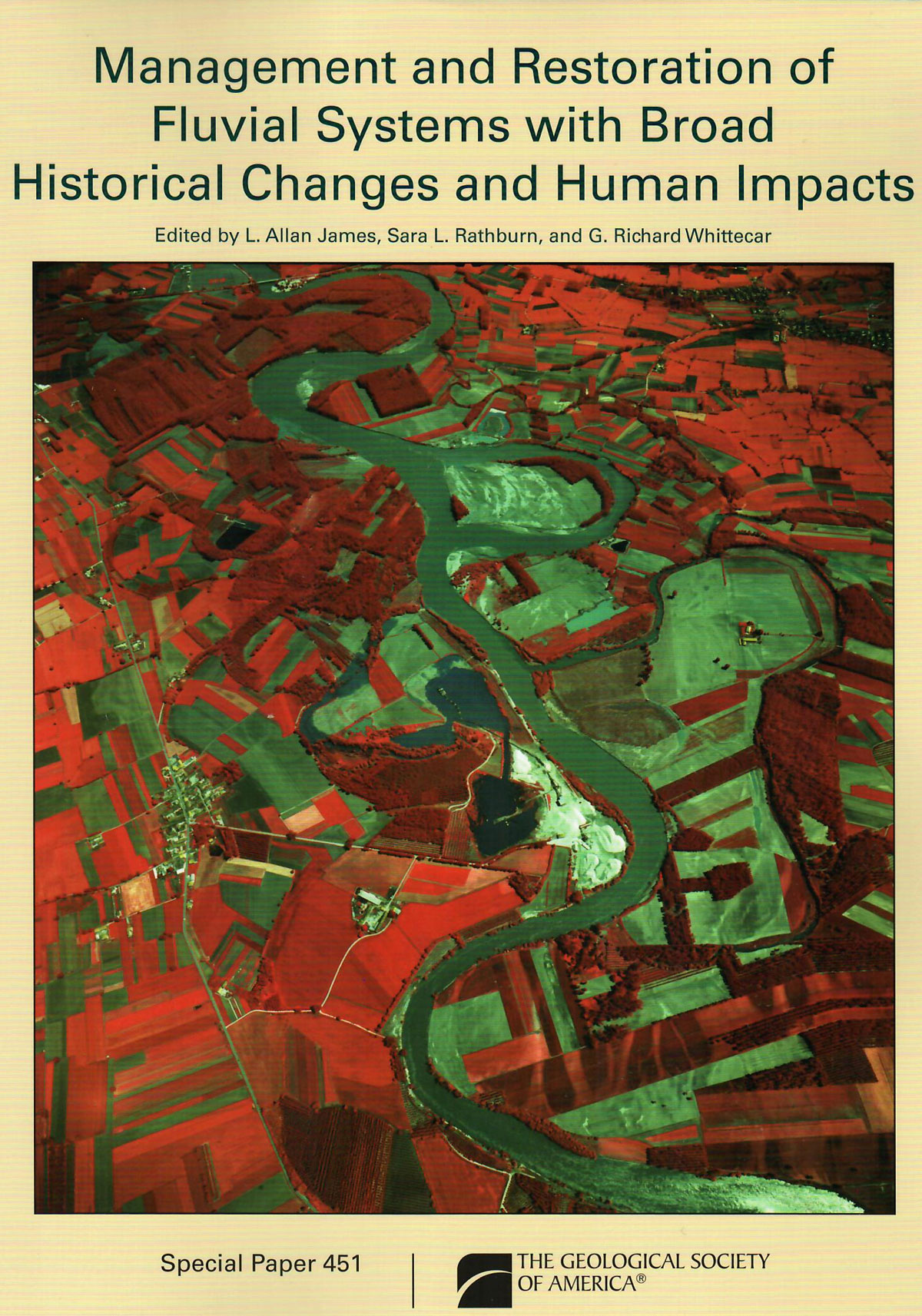
SP 451 - Management and Restoration of Fluvial Systems with broad historical changes and human impacts
Description:
Allen, L. A., et.al., Ed. / MANAGEMENT AND RESTORATION OF FLUVIAL SYSTEMS WITH BROAD HISTORICAL CHANGES AND HUMAN IMPACTS, GSA SP 451, Boulder, 2009, pb, 244 pages, - 1 -, $ 10
Rivers serve as the arteries of environmental systems, the lateral connections that convey pulses of water, sediment, and nutrients down through valley networks. In most watersheds, fluvial geomorphic processes and surface hydrology operate dynamically at various temporal and spatial scales, and intimately influence both flood and drought hazards. Management of surface-water resources has become increasingly urgent as concerns escalate over global environmental change, water scarcity, food production, resource sustainability, and biodiversity. Thus, the science of rivers and the human dimensions of river management now receive unprecedented study. The fourteen papers in this volume bridge classic late-twentieth-century fluvial geomorphology with modern concepts of river management and restoration. They apply perspectives of integrated watershed science, anthropogenic impacts, and historical changes to a modern fluvial geomorphology.
Contents:
Large-Scale, Long-Term Sediment and Geomorphic Changes
Sediment regime constraints on river restoration—An example from the Lower Missouri River
Channel, floodplain, and wetland responses to floods and overbank sedimentation, 1846–2006, Halfway Creek Marsh, Upper Mississippi Valley, Wisconsin
Persistence of effects of high sediment loading in a salmon-bearing river, northern California
Historical channel changes in the lower Yuba and Feather Rivers, California: Long-term effects of contrasting river-management strategies
Channel adjustments in northern and central Italy over the last 200 years
Bank erosion along the dam-regulated lower Roanoke River, North Carolina
Planform change and stream power in the Kishwaukee River watershed, Illinois: Geomorphic assessment for environmental management
Geomorphic evolution of the Le Sueur River, Minnesota, USA, and implications for current sediment loading
Hydrologic Considerations for River Restoration
Vanishing riverscapes: A review of historical channel change on the western Great Plains
Characterizing environmental flows for maintenance of river ecosystems: North Fork Cache la Poudre River, Colorado
Testing the linear relationship between peak annual river discharge and drainage area using long-term USGS river gauging records
River Management and Restoration
Geomorphic changes resulting from floods in reconfigured gravel-bed river channels in Colorado
Assessing geomorphological and ecological responses in restored step-pool systems
River restoration strategies in channelized, low-gradient landscapes of West Tennessee
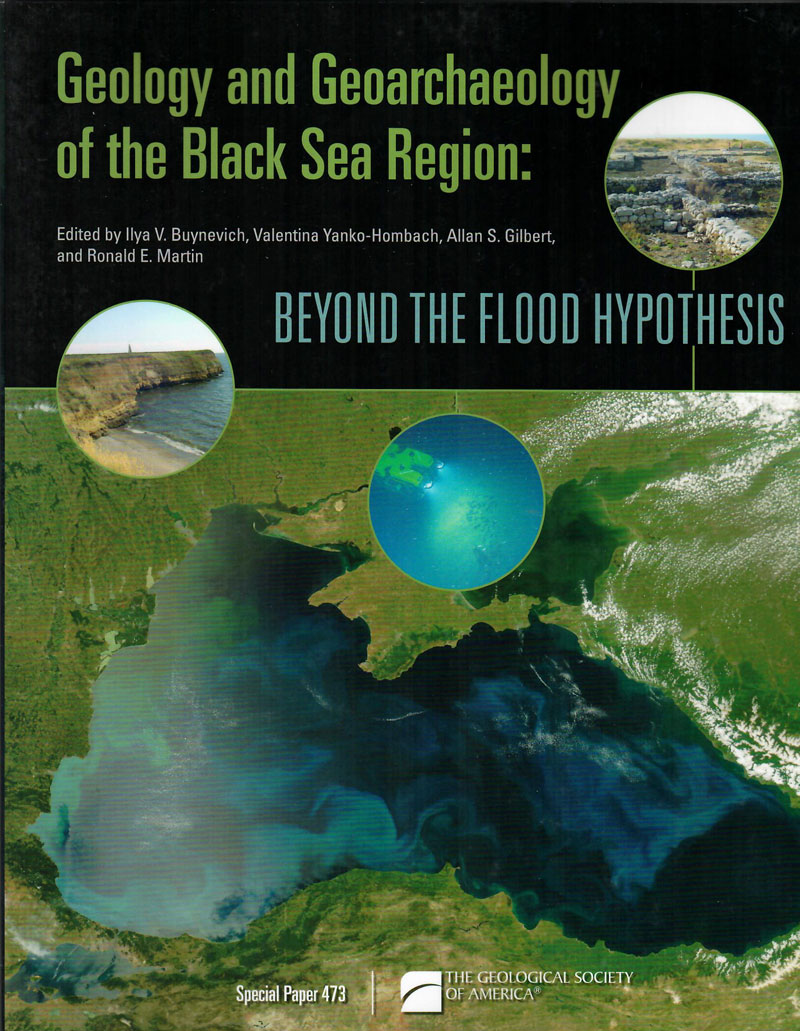
SP 473 - Geology and Geoarchaeology of the Black Sea Region: Beyond the Flood Hypothesis
Description:
Buynevich, I. V., et.al., Ed. / GEOLOGY AND GEOARCHAEOLOGY OF THE BLACK SEA REGION: BEYOND THE FLOOD HYPOTHESIS, GSA SP 473, Boulder, 2011, pb, 196 pages, - 1 -, $ 10
Contributors from twelve countries wrote the twelve chapters in this Special Paper, and they address a range of topics, including climatic and hydrologic modeling, paleogeographic reconstruction of Late Quaternary landscapes, palynology and paleoclimate reconstruction, and geoarchaeological studies, both onshore and offshore. The volume serves as a timely reference for continuing research in a region harboring a number of newly independent states that are now faced with population pressure and a variety of environmental issues.
Contents:
1. Surface runoff to the Black Sea from the East European Plain during Last Glaciation Maximum–Late Glacial time
2. Modeling extreme Black Sea and Caspian Sea levels of the past 21,000 years with general circulation models
3. Assessment of the Black Sea water-level fluctuations since the Last Glacial Maximum
4. Rapid Holocene sea-level and climate change in the Black Sea: An evaluation of the Balabanov sea-level curve
5. Global climate change and sea-level fluctuations in the Black and Caspian Seas over the past 200 years
6. Paleogeography of the Pontic Lowland and northwestern Black Sea shelf for the past 25 k.y.
7. Nonpollen palynomorphs: Indicators of salinity and environmental change in the Caspian–Black Sea–Mediterranean corridor
8. Climatic and environmental oscillations in southeastern Ukraine from 30 to 10 ka, inferred from pollen and lithopedology
9. Late Pleistocene and Holocene paleoenvironments of Crimea: Pollen, soils, geomorphology, and geoarchaeology
10. Bedforms, coastal-trapped waves, and scour process observations from the continental shelf of the northern Black Sea
11. Archaeological oceanography and environmental characterization of shipwrecks in the Black Sea
12. Pontic-Baltic pathways for invasive aquatic species: Geoarchaeological implications
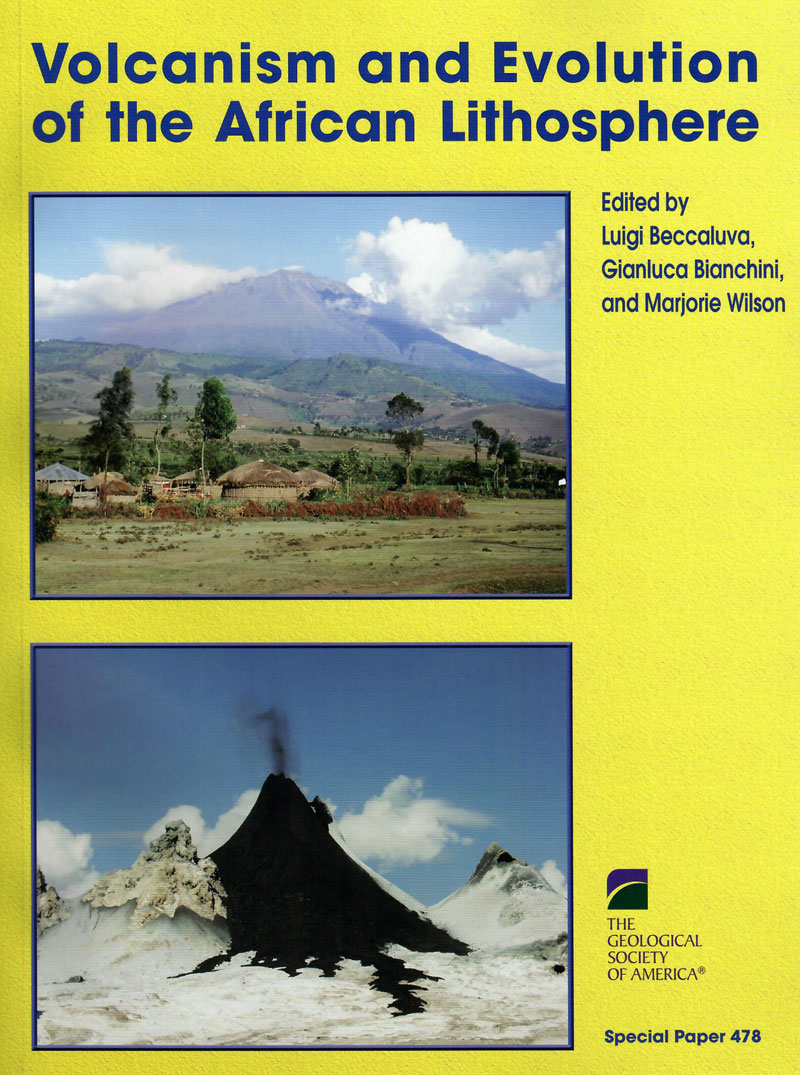
SP 478 - Volcanism and Evolution of African Lithosphere
Description:
Beccalura, L., et.al., Ed. / VOLCANISM AND EVOLUTION OF THE AFRICAN LITHOSPHERE, GSA SP 478, Boulder, 2011, pb, 331 pages, - 1 -, $ 10
The distribution of volcanism in the African plate is the surface expression of a variety of processes, many of which are poorly understood, involving interaction between the lithosphere and the underlying convective mantle. Despite the maturity of the plate tectonic paradigm, our knowledge of the processes involved in the breakup of continents and the formation of new ocean basins remains limited. The African Rift system provides a unique natural laboratory to study the transition from continental breakup to seafloor spreading. Thus, it is important to explore the similarities among the volcanic provinces of the Saharan zone, Cameroon volcanic line, Angola and Namibia, and the East African Rift system. The aim of this volume is to bring together recent and updated contributions on African volcanism (and associated mantle xenoliths), providing multidisciplinary contexts that include volcanology, geochemistry, petrology, geophysics, and structural geology, for a better understanding of the geological evolution of the African lithosphere.
Contents:
1. Late Mesozoic to Quaternary intraplate magmatism and its relation to the Neoproterozoic lithosphere in NE Africa—New data from lower-crustal and mantle xenoliths from the Bayuda volcanic field, Sudan
2. Holocene opening directions along the axes of the Red Sea (Afar) and Main Ethiopian Rifts: An overview
3. The upper-mantle low-velocity anomaly beneath Ethiopia, Kenya, and Tanzania: Constraints on the origin of the African superswell in eastern Africa and plate versus plume models of mantle dynamics
4. The Ethiopia Afar Geoscientific Lithospheric Experiment (EAGLE): Probing the transition from continental rifting to incipient seafloor spreading
5. Peridotite xenoliths from Ethiopia: Inferences about mantle processes from plume to rift settings
6. Evolution of the lithospheric mantle beneath the East African Rift in Tanzania and its potential signatures in rift magmas
7. Petrology and geochemistry of alkaline lava series, Kilimanjaro, Tanzania: New constraints on petrogenetic processes
8. Trace-element distribution between coexisting aqueous fumarole condensates and natrocarbonatite lavas at Oldoinyo Lengai volcano, Tanzania
9. Cameroon Line alkaline magmatism (central Africa): A reappraisal
10. Mineralogical and geochemical fingerprints of mantle metasomatism beneath Nyos volcano (Cameroon volcanic line)
11. Dolomitic volcanism in Zambia: Cr and K signatures and comparisons with other dolomitic melts from the mantle
12. Post-Paleozoic magmatism in Angola and Namibia: A review
13. Is the African cratonic lithosphere wet or dry?
14. New 40Ar-39Ar ages and petrogenesis of the Massif d'Ambre volcano, northern Madagascar
15. Metasomatism versus host magma infiltration: A case study of Sal mantle xenoliths, Cape Verde Archipelago
16. Magmatic evidence for African mantle propagation into the southern Tyrrhenian backarc region
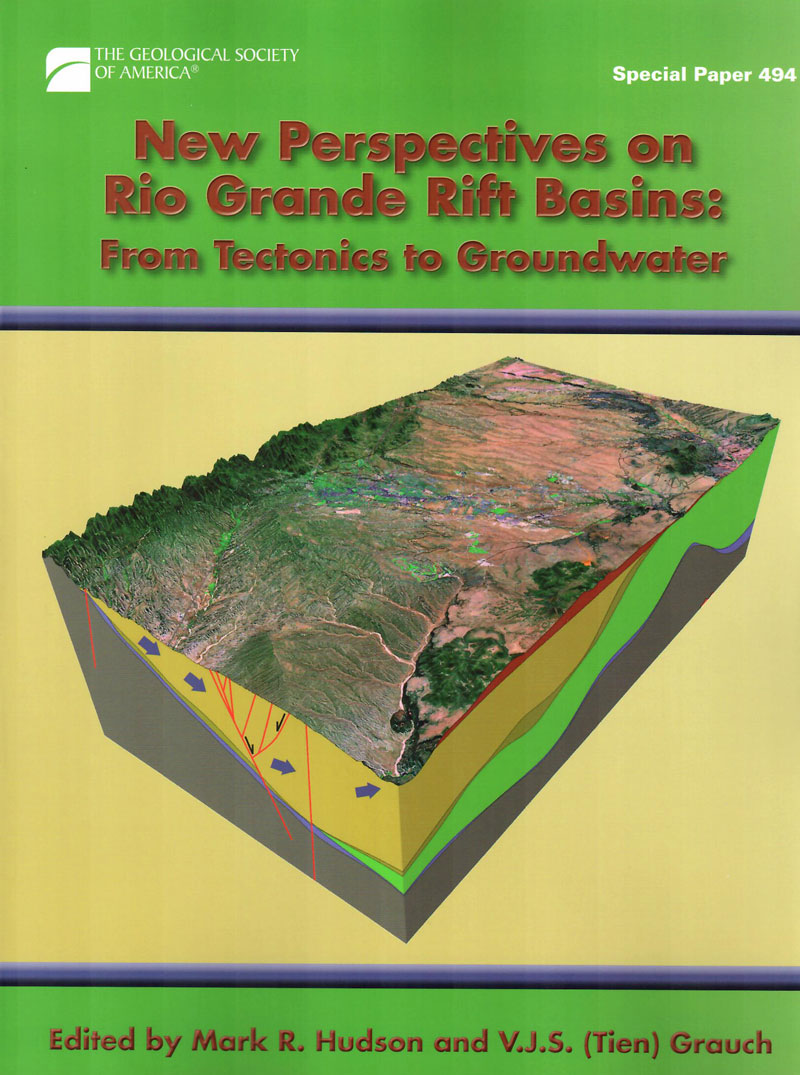
SP 494 - New Perspectives on Rio Grande Rift Basins: From Tectonics to Groundwater
Description:
Hudson, M. R. and Grauch, V. J. S. (Tien), Ed. / NEW PERSPECTIVES ON RIO GRANDE RIFT BASIN: FROM TECTONICS TO GROUNDWATER, GSA SP 494, Boulder, 2013, pb, 500 pages, cd (in pocket), - 1 -, $ 20
Extending from Colorado, USA, on the north to the state of Chihuahua, Mexico, on the south, the Rio Grande rift divides the Colorado Plateau on the west from the interior of the North American craton on the east. This volume focuses on the Rio Grande rift’s upper crustal basins and is organized geographically with study areas progressing from north to south. Eighteen chapters cover a variety of topics, including sedimentation history, rift basin geometries and the influence of older structure on rift basin evolution, faulting and strain transfer within and among basins, relations of magmatism to rift tectonism, and basin hydrogeology.
Contents:
1. Evolution of ancient Lake Alamosa and integration of the Rio Grande during the Pliocene and Pleistocene
2. Provenance of volcanic clasts from the Santa Fe Group, Culebra graben of the San Luis Basin, Colorado: A guide to tectonic evolution
3. Late Miocene–Pleistocene evolution of a Rio Grande rift subbasin, Sunshine Valley–Costilla Plain, San Luis Basin, New Mexico and Colorado
4. Geophysical constraints on Rio Grande rift structure in the central San Luis Basin, Colorado and New Mexico
5. Syndepositional deformation and provenance of Oligocene to Lower Miocene sedimentary rocks along the western margin of the Rio Grande rift, Jemez Mountains, New Mexico
6. Deformational and erosional history for the Abiquiu and contiguous area, north-central New Mexico: Implications for formation of the Abiquiu embayment and a discussion of new geochronological and geochemical analysis
7. Three-dimensional finite-element modeling of fault interactions in rift-scale normal fault systems: Implications for the late Cenozoic Rio Grande rift of north-central New Mexico
8. Structure and tectonic evolution of the eastern Española Basin, Rio Grande rift, north-central New Mexico
9. Chronology of volcanism, tectonics, and sedimentation near the western boundary fault of the Española Basin, Rio Grande rift, New Mexico
10. Multi-stage Laramide deformation in the area of the southern Santa Fe embayment (Rio Grande rift), north-central New Mexico
11. Shallow groundwater geochemistry in the Española Basin, Rio Grande rift, New Mexico: Evidence for structural control of a deep thermal source
12. Upper Neogene tephrochronologic correlations of the Española Basin and Jemez Mountains volcanic field, northern Rio Grande rift, north-central New Mexico
13. Geophysical constraints on Rio Grande rift structure and stratigraphy from magnetotelluric models and borehole resistivity logs, northern New Mexico
14. Oblique transfer of extensional strain between basins of the middle Rio Grande rift, New Mexico: Fault kinematic and paleostress constraints
15. Climatic controls on nonmarine depositional sequences in the Albuquerque Basin, Rio Grande rift, north-central New Mexico
16. New perspectives on the geometry of the Albuquerque Basin, Rio Grande rift, New Mexico: Insights from geophysical models of rift-fill thickness
17. Upper crustal structure of the southern Rio Grande rift: A composite record of rift and pre-rift tectonics
18. Tascotal Mesa transfer zone—An element of the Border Corridor transform system, Rio Grande rift of West Texas and adjacent Mexico
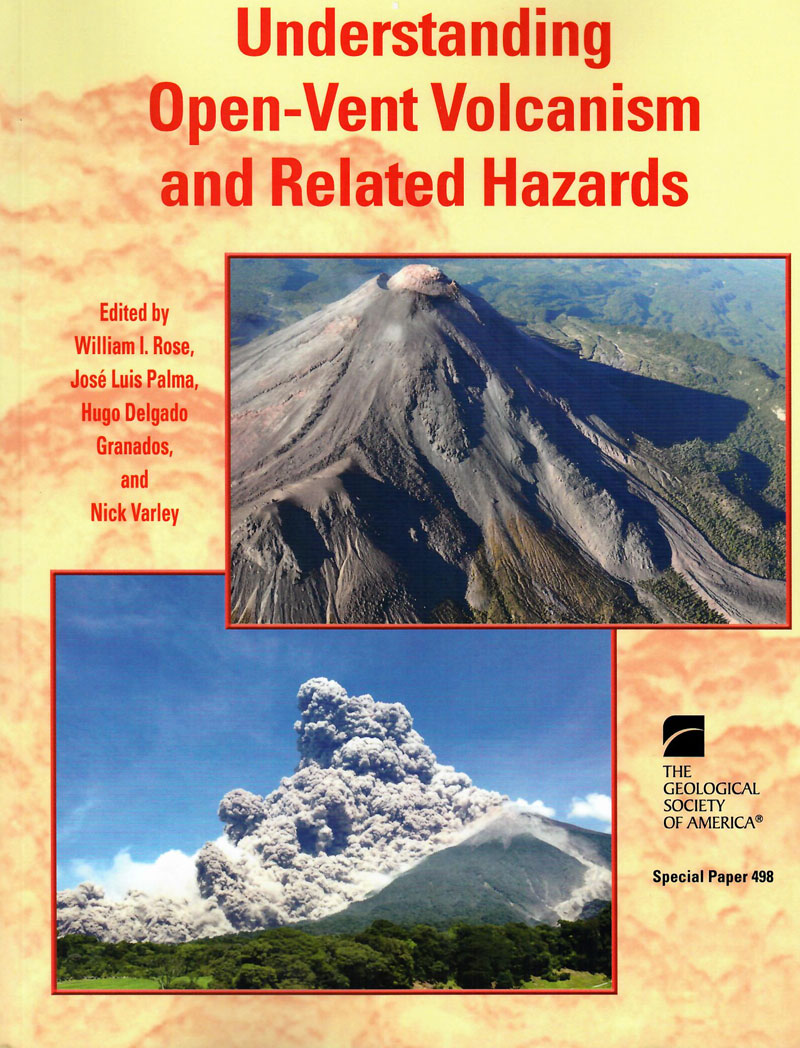
SP 498 - Understanding Open-Vent Volcanism and Related Hazards
Description:
Rose, W. I., et.al., Ed. / UNDERSTANDING OPEN-VENT VOLCANISM AND RELATED HAZARDS, GSA SP 498, Boulder, 2013, 230 pages, - 1 -, $ 10
Volcanic hazards work in developing countries is evolving and is increasingly done by scientists and engineers in home countries. At the same time, scientists in the developed world, where volcanic hazards may not be as immediate, are eager to participate in collaborative efforts, especially to highlight new tools. The lure of working at sites where there is diverse volcanic activity is strong, and collaborative science provides support for infrastructure development in home countries. Experience participating in international collaborative work during real volcanic crises is especially valuable to young scientists engaged in graduate and postdoctoral studies. This volume is the third GSA Special Paper this decade to focus on Central American volcanic hazards, and these chapters demonstrate continued maturation of international hazards work.
Contents:
1. A 50 yr eruption of a basaltic composite cone: Pacaya, Guatemala
2. Crater lake evolution at Santa Ana Volcano (El Salvador) following the 2005 eruption
3. Continuous subsidence associated with the long-lasting eruption of Arenal Volcano (Costa Rica) observed by dry-tilt stations
4. A pilot GPS study of Santa Ana Volcano (Ilamatepec) and Coatepeque caldera, El Salvador
5. Gravity and geodesy of Concepción Volcano, Nicaragua
6. An analysis of the seismic activity of Popocatépetl Volcano, Mexico, associated with the eruptive period of December 2002 to February 2003: Looking for precursors
7. Temporal changes in eruptive behavior identified with coda wave interferometry and seismo-acoustic observations at Fuego Volcano, Guatemala
8. Insights into explosion dynamics and the production of ash at Stromboli from samples collected in real-time, October 2009
9. Large-volume Barriles and Caisán debris avalanche deposits from Volcán Barú, Panama
10. Hazards related to lava tubes and caves in the Sierra Chichinautzin monogenetic volcanic field (México)
11. Estimation of tephra-fall and lahar hazards at Hudson Volcano, southern Chile: Insights from numerical models
12. Explosive volcanic history and hazard zonation maps of Boquerón Volcano (San Salvador volcanic complex, El Salvador)
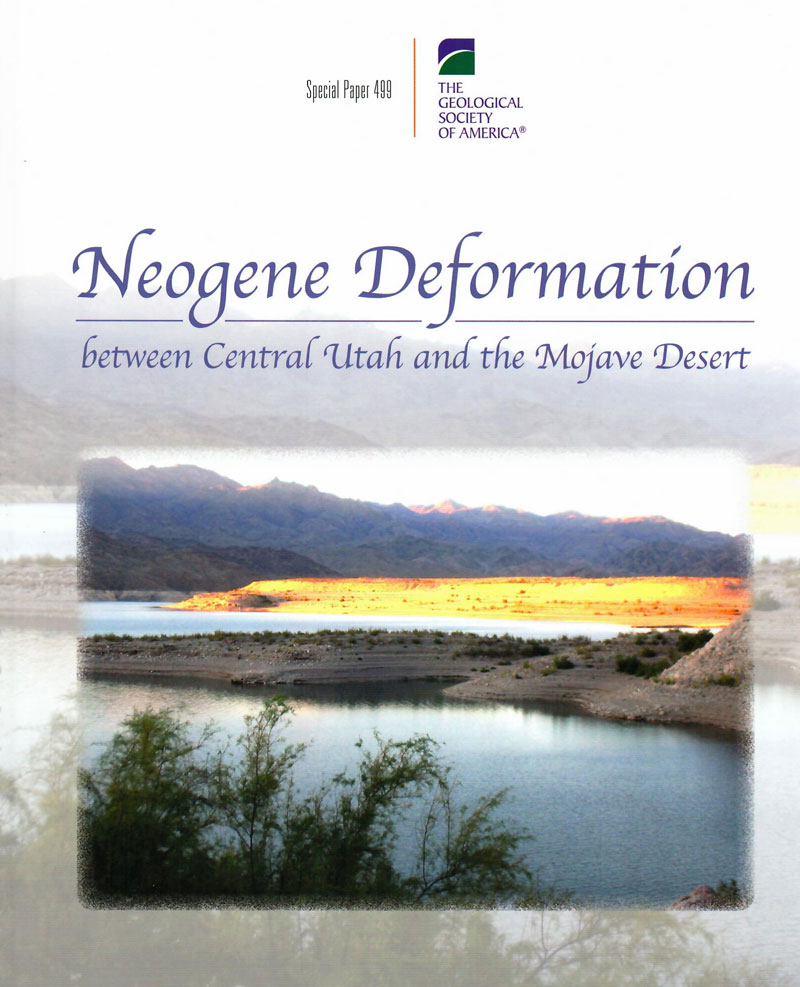
Description:
Anderson, R. E., Ed. / NEOGENE DEFORMATION BETWEEN CENTRAL UTAH AND THE MOJAVE DESERT, GSA SP 499, Boulder, 2013, pb, 94 pages, - 1 -, $ 10
This book is a must-read for researchers interested in extensional tectonics in general and the Neogene tectonics of the Basin and Range in particular, because it challenges, on the basis of more than 50 years of field studies, the existing paradigm of province-wide uniformly large extension and replaces it with a model integrating extension with extension-normal shortening-both as primary strains. The first chapter takes the reader on two journeys southwestward from central Utah through the Lake Mead area: the first to emphasize the lack of uniformly distributed or integrated extension and the second to highlight left-lateral shear at 13 localities along the east margin of the Basin and Range that is kinematically compatible with right-lateral shear along the west margin. The compatibility provides a basis for understanding the extreme Neogene tectonics of the Lake Mead area. The second chapter summarizes multifaceted field evidence from the well-studied eastern Lake Mead area as a focused example of the need for a complete revision of the extensional paradigm.
Contents:
1. Analysis of Neogene deformation between Beaver, Utah, and Barstow, California: Suggestions for altering the extensional paradigm
2. On the importance of non-uniform tilt, strike slip, and hydrogeology in shaping the Neogene tectonics of the eastern Lake Mead area
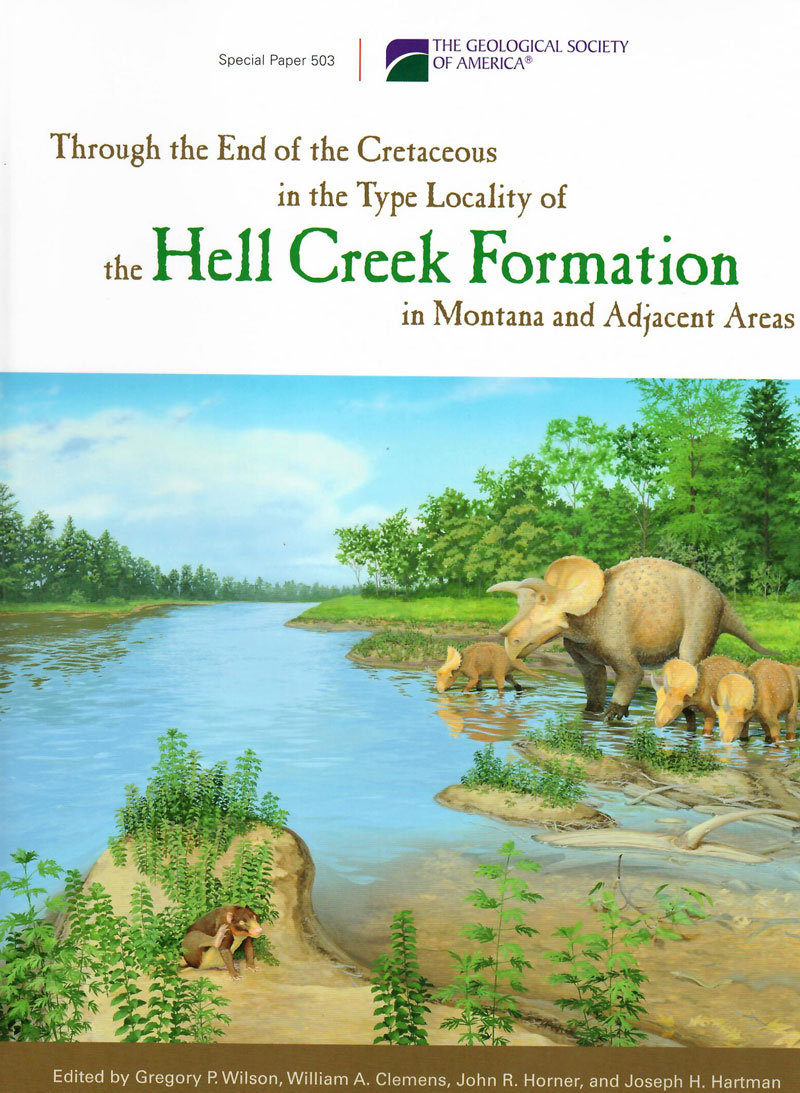
SP 503 - Through the end of the Cretaceous in the type locality of the Hell Creek Formation in Montana and adjacent areas
Description:
Wilson, G. P., et.al., Ed. / THROUGH THE END OF THE CRETACEOUS IN THE TYPE LOCALITY OF THE HELL CREEK FORMATION IN MONTANA AND ADJACENT AREAS, GSA SP 503, Boulder, pb, 392 pages, - 1 -, $ 15
For over a century, the Hell Creek and Fort Union formations and their constituent fossil biotas have captivated geologists and paleontologists alike. In Montana and adjacent areas, these rocks have become renowned as the type locality for Tyrannosaurus rex and the epicenter for debate surrounding the mass extinction of dinosaurs at the Cretaceous-Paleogene boundary. The chapters in this volume represent a surge of field and laboratory research activity that illustrates the impacts of new and refined methods and tools. In tandem, the research questions have evolved to take advantage of the increased precision, quality, and quantity of the data, from determinations of paleoecologies to assessment of ontogenetic sequences, patterns of sedimentation, and basin-level intraformational correlations. Together, the chapters in this volume are a major step forward in the quest to mine the rich lode of geologic and biologic history preserved in the strata bounding the Cretaceous-Paleogene boundary.
Contents:
1. From Tyrannosaurus rex to asteroid impact: Early studies (1901–1980) of the Hell Creek Formation in its type area
2. Context, naming, and formal designation of the Cretaceous Hell Creek Formation lectostratotype, Garfield County, Montana
3. Assessing the relationships of the Hell Creek–Fort Union contact, Cretaceous-Paleogene boundary, and Chicxulub impact ejecta horizon at the Hell Creek Formation lectostratotype, Montana
4. Magnetostratigraphy of the Hell Creek and lower Fort Union Formations in northeastern Montana
5. Carbon isotope stratigraphy and correlation of plant megafossil localities in the Hell Creek Formation of eastern Montana
6. A florule from the base of the Hell Creek Formation in the type area of eastern Montana: Implications for vegetation and climate
8. Euselachians from the freshwater deposits of the Hell Creek Formation of Montana

SP 505 - Volcanism, Impacts, and Mass Extinctions: Causes & Effects
Description:
Keller, G. and Kerr, A. C. / VOLCANISM, IMPACTS, AND MASS EXTINCTIONS: CAUSES & EFFECTS, GSA SP 505, pb, 2014, 455 pages, - 1 -, $ 30
This volume comprises articles stemming from the international, multi-disciplinary conference that took place in March 2013 at London's Natural History Museum (NHM). This conference brought together researchers across geological, geophysical, and biological disciplines to assess the state of research into the causes of mass extinction events and, in particular, to evaluate the respective roles of volcanism, bolide impacts, and associated climate and environmental changes. Key results of this seminal conference are presented in papers spanning a wide range of disciplines. Participants concluded that large igneous province volcanism along with associated climate and environmental changes played significant roles in four of the five major mass extinctions in Earth history. There was overwhelming agreement that a single large asteroid or comet impact (Chicxulub) could not have been the sole cause of the end-Cretaceous mass extinction, but rather was a contributing factor along with volcanism.
Contents:
Mass Extinctions, Volcanism, and Impacts
1. The geological extinction record: History, data, biases, and testing
2. Large igneous provinces and mass extinctions: An update
3. Deccan volcanism, the Chicxulub impact, and the end-Cretaceous mass extinction: Coincidence? Cause and effect?
4. Effects of Deccan volcanism on paleoenvironment and planktic foraminifera: A global survey
5. Plants and floral change at the Cretaceous-Paleogene boundary: Three decades on
6. The early Danian hyperthermal event at Boltysh (Ukraine): Relation to Cretaceous-Paleogene boundary events
7. Plant macrofossils from Boltysh crater provide a window into early Cenozoic vegetation
8. Deccan volcanic eruptions and their impact on flora: Palynological evidence
9. Vertebrate fauna from the Deccan volcanic province: Response to volcanic activity
10. What the dinosaur record says about extinction scenarios
11. The Pliensbachian–Toarcian (Early Jurassic) extinction: A North American perspective
12. Volcanism of the Central Atlantic magmatic province as the trigger of environmental and biotic changes around the Triassic-Jurassic boundary
13. Climatic reversals related to the Central Atlantic magmatic province caused
the end-Triassic biotic crisis—Evidence from continental strata in Poland
14. An earth system approach to understanding the end-Ordovician (Hirnantian) mass extinction
Volcanism and Environmental Effects
15. A review of the embedded time scales of flood basalt volcanism with special emphasis on dramatically short magmatic pulses
16. Emplacement characteristics, time scales, and volcanic gas release rates of continental flood basalt eruptions on Earth
17. Modeling the carbon-sulfate interplays in climate changes related to the emplacement of continental flood basalts
Mickaël Mussard, Guillaume Le Hir, Frédéric Fluteau, Vincent Lefebvre, and Yves Goddéris
18. Atmospheric halogen and acid rains during the main phase of Deccan eruptions: Magnetic and mineral evidence
Impacts and Environmental Effects
19. Impact volcanism and mass extinctions
20. The role of giant comets in mass extinctions
21. Implications of the centaurs, Neptune-crossers, and Edgeworth-Kuiper belt for terrestrial catastrophism
22. Calendar-year dating of the Greenland Ice Sheet Project 2 (GISP2) ice core from the early sixth century using historical, ion, and particulate data
23. What caused terrestrial dust loading and climate downturns between A.D. 533 and 540?
24. The public impact of impacts: How the media play in the mass extinction debates
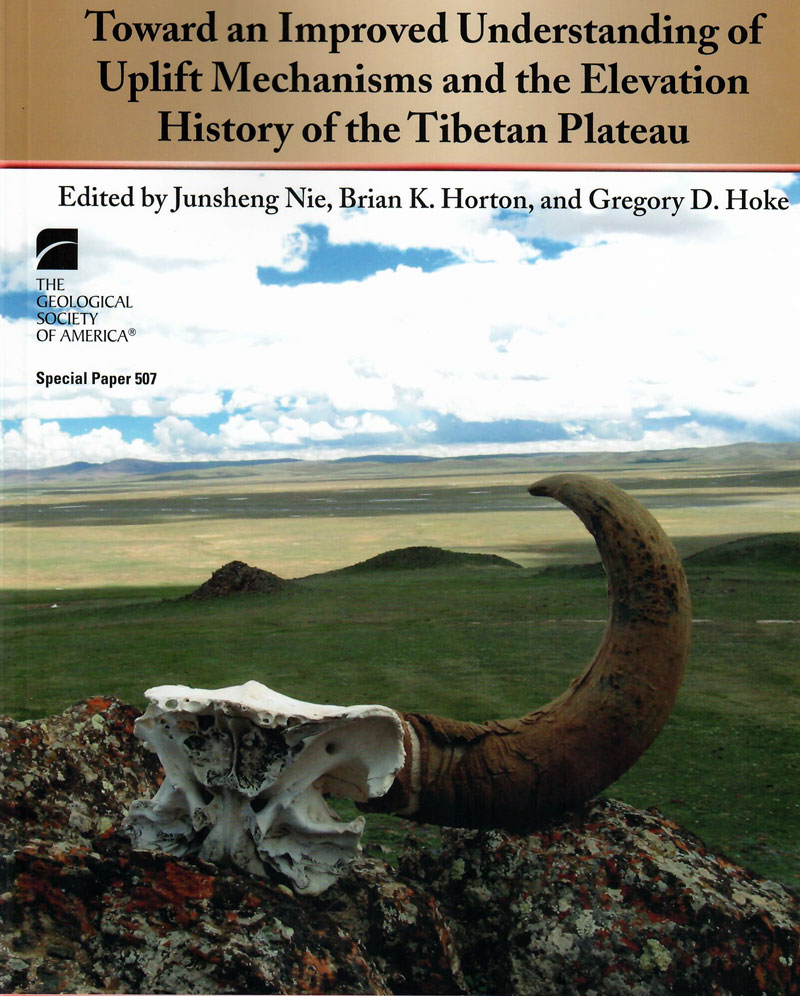
SP 507 - Uplift Mechanisms and the History of the Tibetan Plateau
Description:
Nie, J. et.al. / TOWARD AN IMPROVED UNDERSTANDING OF UPLIFT MECHANISMS AND THE HISTORY OF THE TIBETAN PLATEAU, GSA SP 507, Boulder, 2014, pb, 153 pages, - 1 -, $ 10
Defining the mechanisms responsible for topographic growth of the Tibetan Plateau has challenged geoscientists for decades. Deformation histories, sediment accumulation records, and thermochronology results suggest that plateau construction is likely the result of a protracted history of deformation that initiated before and continued throughout the Cenozoic India-Asia collision. However, key questions remain. What was the relative importance and magnitudes of pre-Cenozoic, Paleogene, and Neogene shortening? Has elevation gain in Tibet been punctuated or continuous? Did the Tibetan Plateau experience a shift in deformation kinematics during the Cenozoic and, if so, what were the driving mechanisms? How have tectonics and climate interacted during construction of the Tibetan Plateau? Advances in our understanding of these issues can be found in this volume.
Contents:
Early Cretaceous to present latitude of the central proto-Tibetan Plateau: A paleomagnetic synthesis with implications for Cenozoic tectonics, paleogeography, and climate of Asia
Tectonics and topographic evolution of Namche Barwa and the easternmost Lhasa block, Tibet
Northern Lhasa thrust belt of central Tibet: Evidence of Cretaceous–early Cenozoic shortening within a passive roof thrust system?
Mesozoic tectonic history and lithospheric structure of the Qiangtang terrane: Insights from the Qiangtang metamorphic belt, central Tibet
Structure and detrital zircon geochronology of the Domar fold-thrust belt: Evidence of pre-Cenozoic crustal thickening of the western Tibetan Plateau
Cenozoic mountain building on the northeastern Tibetan Plateau
Timing and spatial patterns of basin segmentation and climate change in northeastern Tibet
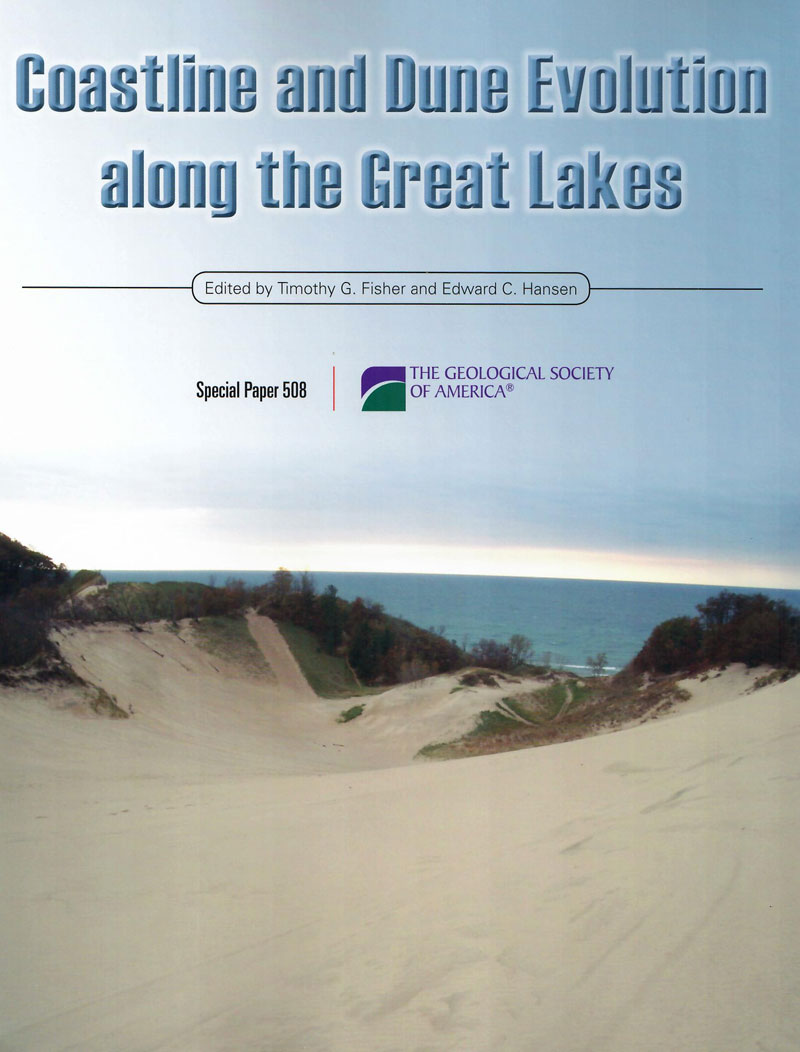
SP 508 - Coastline and Dune Evolution along the Great Lakes
Description:
Fisher, T. G. and Hansen, E. C. / COASTLINE AND DUNE EVOLUTION ALONG THE GREAT LAKES, GSA Special Paper 508, Boulder, 2014, pb, 228 pages, - 1 -. $ 10
The 17,500 km of Great Lakes' shoreline is North America's "third coast." This coast has been the setting for a number of classic studies in coastal geomorphology and Quaternary geology, especially on the subjects of coastal dunes and the effects of deglaciation and isostatic rebound on lakes and coasts. In the past decade and a half, there has been a revival of interest in these processes along the Great Lakes. This volume includes an interdisciplinary mix of papers spanning a variety of temporal scales and offering a substantive overview of this recent research. The majority of the papers investigate the relationship between dune activity, lake levels, and climate. In addition to offering insights into coastal processes in general, the data presented in this paper could help inform decisions on how to manage and mitigate the human impact on this fragile natural environment.
Contents:
1. A previously unrecognized path of early Holocene base flow and elevated discharge from Lake Minong to Lake Chippewa across eastern Upper Michigan
2. The contemporary elevation of the peak Nipissing phase at outlets of the upper Great Lakes
3. Late Holocene coastal development along the southern shore of Lake Michigan determined by strategic dating of stabilized parabolic dunes and wetlands of the Tolleston Beach
4. Late Holocene dune development and shift in dune-building winds along southern Lake Michigan
5. Dune formation on late Holocene sandy bay barriers along Lake Michigan’s Door Peninsula: The importance of increased sediment supply following the Nipissing and Algoma high lake-level phases
6. Coastal geology and recent origins for Sand Point, Lake Superior
7. Sand in lakes and bogs in Allegan County, Michigan, as a proxy for eolian sand transport
8. Elucidating paleo dune activity and timing from wetlands in the lee of coastal sand dunes, Grand Mere Lakes, Michigan
9. Temporally constrained eolian sand signals and their relationship to climate, Oxbow Lake, Saugatuck, Michigan 10. The role of extratropical cyclones in shaping dunes along southern and southeastern Lake Michigan
11. Short- and long-term perspectives on the evolution of a Lake Michigan foredune
12. Using remote sensing and geospatial analysis to understand changes to Lake Michigan dunes
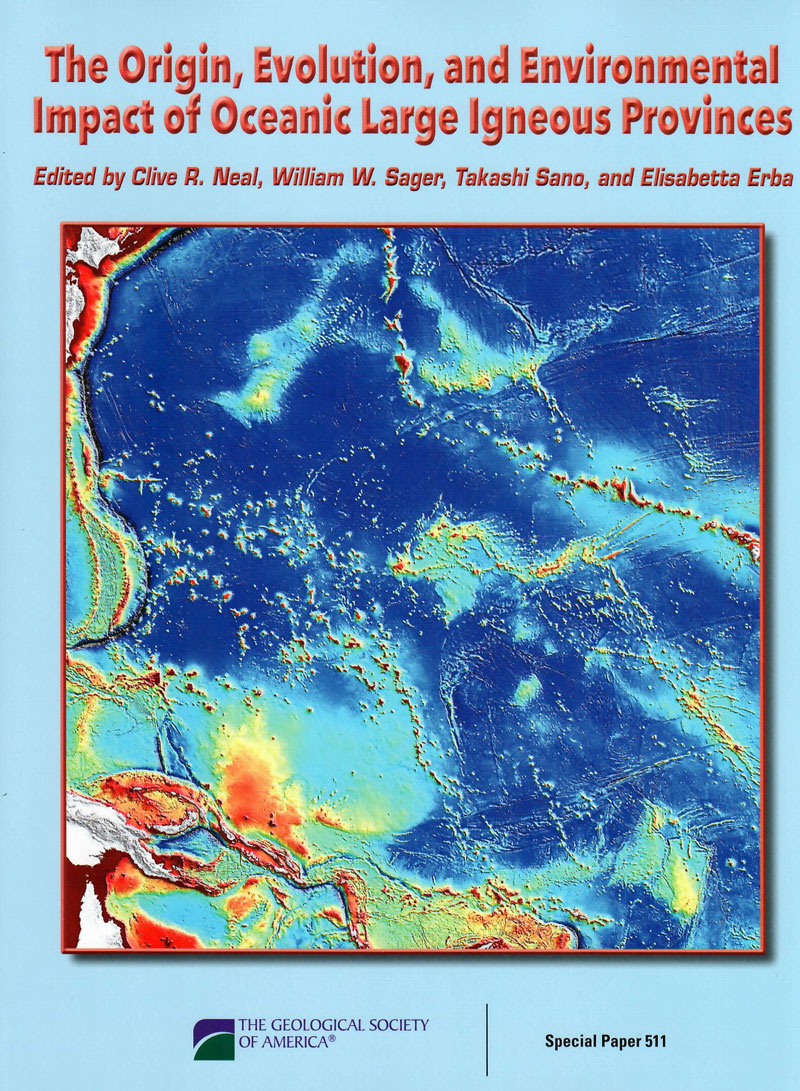
SP 511 - The Origin, Evolution, and Environmental Impact of Oceanic Large Igneous Provinces
Description:
Neal, C. R., et.al. / THE ORIGIN, EVOLUTION, AND ENVIRONMENTAL IMPACT OF OCEANIC LARGE IGNEOUS PROVINCES, GSA SP 511, Boulder, 2015, pb, 339 pages, - 1 -, $ 20
The origin, evolution, and environmental impact of large igneous provinces (LIPs) represents a topic of high scientific importance because the magmatism associated with these features cannot be directly related to plate tectonics, and because the eruption of flood basalts may have global environmental consequences. Oceanic LIPs are even more poorly understood due to their relative inaccessibility. This volume takes a multidisciplinary approach to understanding LIP origin, evolution, and environmental impact in ocean basins. Papers that focus on plate tectonic reconstructions, petrologic and geophysical investigations of various LIPs, and sedimentological and micropaleontological evidence of syn-LIP sediments are presented. Precious materials and data from dredging cruises and scientific ocean drilling expeditions have made this volume possible.
Contents:
PART 1: HAWAII AND THE AZORES
1. Petrology, geochemistry, and ages of lavas from Northwest Hawaiian Ridge volcanoes
2. Geochemical and geochronological constraints on the evolution of the Azores Plateau
PART 2: SHATSKY RISE
3. Noble gas evidence for the presence of recycled material in magma sources of the Shatsky Rise
4. Boron and chlorine contents of basalts from the Shatsky Rise, IODP Expedition 324: Implications for the alteration of oceanic plateaus
5. Reorganization of the Pacific-Izanagi-Farallon triple junction in the Late Jurassic: Tectonic events before the formation of the Shatsky Rise
6. The Shatsky Rise oceanic plateau structure from two-dimensional multichannel seismic reflection profiles and implications for oceanic plateau formation
7. Application of the two-dimensional continuous wavelet transforms to imaging of the Shatsky Rise plateau using marine seismic data
8. Paleomagnetism of igneous rocks from the Shatsky Rise: Implications for paleolatitude and oceanic plateau volcanism
9. Lithium isotope evidence for magmatic assimilation of hydrothermally influenced crust beneath oceanic large igneous provinces
PART 3: ONTONG JAVA PLATEAU
10. Tectonic reconstructions in magnetic quiet zones: Insights from the greater Ontong Java Plateau
11. Topographic expression of the Danger Islands Troughs and implications for the tectonic evolution of the Manihiki Plateau, western equatorial Pacific Ocean
12. Homogenization of magmas from the Ontong Java Plateau: Olivine-spinel compositional evidence
13. Alkalic magmatism in the Lyra Basin: A missing link in the late-stage evolution of the Ontong Java Plateau
14. Isotopic evidence for a link between the Lyra Basin and Ontong Java Plateau
PART 4: OCEANIC ANOXIC EVENTS AND CRETACEOUS ENVIRONMENTAL PERTURBATIONS
15. Environmental consequences of Ontong Java Plateau and Kerguelen Plateau volcanism
16. Geochemistry of an Aptian bedded chert succession from the deep Pacific basin: New insights into Cretaceous oceanic anoxic event (OAE)1a
17. Intersite discrepancy in the amplitude of marine negative δ13C excursion at the onset of early Aptian oceanic anoxic event 1a: Reconciliation through Sr isotopic screening of peculiar diagenetic overprint on the Pacific reference section (Deep Sea Drilling Project Site 463)

SP 513 / Late Jurassic Margin of Laurasia: A Record of Faulting Accomodating Plate Rotation
Description:
Anderson, T. H., et.al., Ed. / Late Jurassic Margin of Laurasia: A Record of Faulting Accommodating Plate Rotation, GSA SP 451, Boulder, 2015, pb, 606 pages, plate in pocket, cd, - 1 -, $ 10
Fast-paced and complex extensional and contractional deformation, between 170 and 148 Ma, along the margin of Laurasia coincides with ocean-floor formation within basins, such as the central Atlantic, the Gulf of Mexico, the Great Valley of California, the Mediterranean Sea, and the southern Caspian Sea. Along the western margin of North America, numerous basins that formed in the Middle Jurassic and continued throughout the Late Jurassic, contemporaneous and co-genetic with igneous activity, are kinematically compatible with sinistral strike-slip fault movement, suggesting a transtensional origin. Comparable basins are postulated to have developed in Russia, Mongolia, China, and Iran. Domains of contractional deformation, attributed to transpression, such as the Blue Mountains (Oregon, USA), the Chersky collision belt (Siberia, Russia), and the early Yinshan fold-thrust belt (northern China), interrupt the belt of Late Jurassic basins. The tectonic evolution that is characterized by linkages among faults and fault-related structures along the margin of the Laurasian plate may be interpreted as recording plate rotation during the breakup of Pangea.
Contents:
Evolution of the Caribbean plate and origin of the Gulf of Mexico in light of plate motions accommodated by strike-slip faulting
Detrital zircon provenance of the eastern Gulf of Mexico subsurface: Constraints on Late Jurassic paleogeography and sediment dispersal of North America
Jurassic (170–150 Ma) basins: The tracks of a continental-scale fault, the Mexico-Alaska megashear, from the Gulf of Mexico to Alaska
Construction of the Jurassic magmatic arc, southeast California and southwest Arizona
Temporal and tectonic relations of early Mesozoic arc magmatism, southern Sierra Nevada, California
Detrital-zircon record of the early Mesozoic southwestern Sierra Nevada arc preserved in Lower Cretaceous intra-arc and forearc deposits of central California, USA
Cuesta Ridge ophiolite, San Luis Obispo, California: Implications for the origin of the Coast Range ophiolite
Jurassic evolution of the Western Sierra Nevada metamorphic province
Mid-Jurassic to early Miocene clastic deposition along the northern California margin: Provenance and plate-tectonic speculations
Composite Sunrise Butte pluton: Insights into Jurassic–Cretaceous collisional tectonics and magmatism in the Blue Mountains Province, northeastern Oregon
The record of volcanism in the Brushy Basin Member of the Morrison Formation: Implications for the Late Jurassic of western North America
Sedimentary geochemistry of the Peshastin Formation and Darrington Phyllite, Cascade Mountains, Washington State: Provenance, tectonic setting, and regional implications
Mesozoic tectono-stratigraphic terranes of the Koryak-Chukotka region
Paleomagnetism and geochemistry of the Kiselevka block of the Kiselevka-Manoma terrane (northern Sikhote-Alin): Geodynamic significance
Jurassic geodynamic history of the Sikhote-Alin-Priamurye region
Geodynamic evolution of the East Asian continental margin in the Mesozoic exemplified from the Bureya Basin
Sedimentary basins in transition: Distribution and tectonic settings of Mesozoic strata in Mongolia
Tectonic transformations in the north of eastern China during 170–150 Ma: Causal linkage to the rapid formation of the paleo–Pacific plate
Latest Jurassic–earliest Cretaceous closure of the Mongol-Okhotsk Ocean: A paleomagnetic and seismological-tomographic analysis
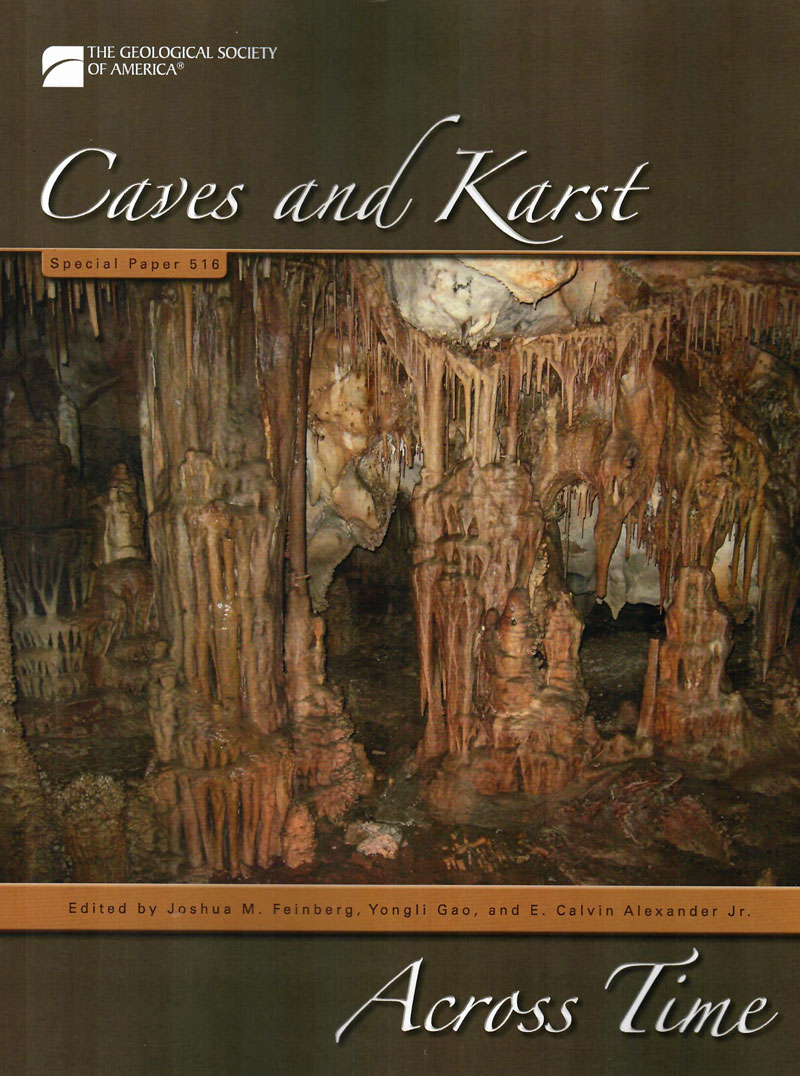
SP 516 - Caves and Karst Across Time
Description:
Feinberg, J. M., Gao, Y., and Alexander, E. C. / CAVES AND KARST ACROSS TIME, GSA SP 516, Boulder, 2016, pb, 300 pages, - 1 -, $ 25
Appreciation, knowledge, and understanding of cave and karst systems have evolved dramatically since the creation of the Geological Society of America in 1888. Caves are now widely recognized as important geological features and karst as a distinctive and significant geologic system that covers about 20% of the planet's land surface. Karst aquifers are the world's most productive yet vulnerable groundwater systems, serving as the sole or primary water supply for more than one billion people worldwide. Karst systems have evolved dynamically across time, reflecting changes in climate and regional tectonism, and the subsequent crustal scale hydrologic responses invoked by these processes. We are now aware of the complexity of groundwater flow within karst and epikarst systems, and are striving to link our understanding of such heterogeneous flow processes to contamination studies and hazard assessment. This Special Paper highlights the changes in the study and application of cave and karst systems since GSA's origin, while looking ahead to future advancements.
Contents:
HISTORICAL PERSPECTIVES ON CAVES AND KARST RESEARCH
1. The science of caves and karst: From the beginning of the Geological Society of America to 1960
2. Science of caves and karst: A half century of progress
3. Karst mapping in the United States: Past, present, and future
4. Historical review and forward view of cave and karst research in Texas
FORMATIONAL PROCESSES IN
CAVE AND KARST ENVIRONMENTS
5. Morphometric analysis of cave patterns using fractal indices
6. Geologic history of the Black Hills caves, South Dakota
7. Depth and timing of calcite spar and “spar cave” genesis: Implications for landscape evolution studies
THE HYDROGEOLOGY OF KARST AND EPIKARST
8. The importance of advection for CO2 dynamics in the karst critical zone: An approach from dimensional analysis
9. Initial pipe development within epikarst microfractures
10. On the efficacy of monitoring wells in karstic carbonate aquifers
11. Assessing structural control on groundwater flow in the Morrell Cave springshed, Sullivan County, Tennessee
12. Geochemistry of cave pools connected to an alpine epikarst—Timpanogos Cave National Monument, Utah
13. Analysis of hydrologic and geochemical time-series data at James Cave, Virginia: Implications for epikarst influence on recharge in Appalachian karst aquifers
BIOLOGICAL AND ARCHAEOLOGICAL INTERACTIONS WITH CAVES AND KARST
14. Caves, hills, and caches: The importance of karst landscapes for the Prehispanic and contemporary Maya
15. Microclimate and niche constructionism in tropical bat caves: A case study from Mount Elgon, Kenya
PRESERVED WITHIN CAVES AND KARST
16. High-resolution rainfall records for middle and late Holocene based on speleothem annual UV fluorescent layers integrated with stable isotopes and U/Th dating, Raccoon Mountain Cave, Tennessee
17. Middle Pleistocene glacial outwash in poljes of the Dinaric karst
18. Long-distance sediment transport and episodic resedimentation of Pennsylvanian dust (eolian silt) in cave passages of the Mississippian Leadville Limestone, southwestern Colorado
19. Paleomagnetic constraints on the Atapuerca karst development (N Spain)

SP 518 - Large Meteorite Impacts and Planetary Evolution
Description:
Osinki, G. R. and Kring, D. A. / LARGE METEORITE IMPACTS AND PLANETARY EVOLUTION V, GSA SP 518, Boulder, 2015, pb, 227 pages, - 1 -, $ 20
Impact cratering is one of the most fundamental geological processes. On many planets, impact craters are the dominant geological landform. On Earth, erosion, plate tectonics, and volcanic resurfacing continually destroy the impact cratering record, but even here, the geological, biological, and environmental effects of impact cratering are apparent. Impact events are destructive and have been linked to at least one of the "big five" mass extinctions over the past 540 Ma. Intriguingly, impact craters can also have beneficial effects. Many impact craters are associated with economic metalliferous ore deposits and hydrocarbon reservoirs. This Special Paper provides an up-to-date synthesis of impact cratering processes; the role of meteorite impacts in the origin of life, products, and effects; and the techniques used to study impact craters on Earth and other planetary bodies. This volume resulted from the Large Meteorite Impacts and Planetary Evolution V conference held in Sudbury, Canada, in August 2013.
Contents:
The Role of Meteorite Impacts in the Origin of Life
Potential catalytic role of phyllosilicates in pre-biotic organic synthesis
Making Craters: From the Small to the Big
Scaling impact crater dimensions in cohesive rock by numerical modeling and laboratory experiments
Characteristics of impact craters in the northern hemisphere of Mars
Morphologic and structural mapping of the central uplift of Betio crater, Thaumasia Planum, Mars
Kinematics of large terrestrial impact crater formation inferred from structural analysis and three-dimensional block modeling of the Vredefort Dome, South Africa
Scaling of basin-sized impacts and the influence of target temperature
Products of Planetary Impacts
Petrologic and impact size controls on Precambrian spherule diameters
Zircon formation in impact melts: Complications for deciphering planetary impact histories
Microscopic effects of shock metamorphism in zircons from the Haughton impact structure, Canada
Surficial polymict impact breccia unit, Wetumpka impact structure, Alabama: Shock levels and emplacement mechanism
Nature and origin of the Garson Member of the Onaping Formation, Sudbury impact structure, Canada
Remote Sensing Methods to Study Impact Craters
Mapping terrestrial impact craters with the TanDEM-X digital elevation model
Manfred Gottwald, Thomas Fritz, Helko Breit, Birgit Schättler, and Alan Harris
Real-time crater profile analysis: Visualizing high-resolution laser altimetry data sets on the GPU

SP 531 - Paleozoic Stratigraphy and Resources of the Michigan Basin
Description:
Grammar, G. M., et. al., Ed. / PALEOZOIC STRATIGRAPHY AND RESOURCES OF THE MICHIGAN BASIN, Boulder, 2018, pb, 339 pages, - 1 -, $ 10
The Michigan Basin is a classic intracratonic basin that has played a significant role in the fundamental understanding of geological processes in such basins, and has been an important resource for oil and gas, economic minerals, groundwater, and coal. Despite the classic nature of the Michigan Basin, there has not been a "special volume" dedicated to the basin in nearly 25 years. Since that time, new advancements in the geological sciences, particularly the utilization of high-resolution sequence stratigraphy and three-dimensional geostatistical modeling, have led to a new and more comprehensive understanding of the Paleozoic sedimentary packages of the Michigan Basin. This volume provides significant new insights of the Michigan Basin to both academic and applied geoscientists; it includes papers that discuss various aspects of the sedimentology and stratigraphy of key units within the basin, as well as papers that analyze the diverse distribution of natural resources present in this basin.
Contents:
Introduction to the Paleozoic stratigraphy and resources of the Michigan Basin
Regional reservoir characterization of the Ordovician Upper St. Peter Sandstone, Michigan Basin
Geological characterization and assessment of confining layer potential of the Upper Ordovician Utica Shale, Michigan Basin
A reevaluation of the Burnt Bluff Group (Llandovery, Silurian, Michigan Basin) from
subsurface and outcrop data: Development of a time-transgressive depositional model
Utilizing sequence stratigraphy to develop a depositional model for Silurian (Niagaran) reefs in the Michigan Basin
Rock-based 3-D reservoir characterization of a Silurian (Niagaran) reef—Ray gas storage field, Macomb County, Michigan
Windward vs. leeward variability of faunal distribution in a Silurian (Wenlockian) pinnacle reef complex—Ray Reef, Macomb County, Michigan
Porosity characterization in a Silurian reef, northern Michigan Basin, using azimuthal seismic data and potential impacts for enhanced oil recovery
A new sequence stratigraphic model for the Silurian A-1 Carbonate (Ruff Formation) of the Michigan Basin
Evaporite facies of the Michigan Basin
Middle Devonian Sylvania Sandstone, Michigan Basin
Utilization of modern and ancient analogs to constrain 3-D geostatistical models, Devonian of South Buckeye field, Michigan Basin
Controls on stratigraphy and sedimentation of the Mississippian Marshall Formation, Michigan Basin
Late Mississippian (Chesterian) through early Pennsylvanian (Atokan) strata, Michigan Basin
Pennsylvanian Pewamo Formation and Haybridge strata of central Michigan: The youngest rocks of the Michigan Basin?
End of the newer GSA Special Papers Catalog!
Click any link to continue.
Newer GSA Memoirs
Field Guides and Reviews of Engineering Geology
Our regular stock of older GSA Publications < More Memoirs, Special Papers, and Reviews of Engineering Geology can be found in this catalog
GSA DNAG (Decade of North American Geology) Publications
Home Page
Catalogs on this Website
Mineral Specimens
Mineralogy Books
Select Mineral Books
Rock, Gem, and Mineral Books
Geology Books
U.S. State Geology
USGS Publications